Shortly after the M Monochrom (Typ 246) was introduced back in early 2015, I published an article comparing it to an M (Typ 240) with its color files converted to black and white to see if high ISO performance was really superior with a dedicated monochrome sensor, along with the previous M Monochrom (M9M) to gauge any generational improvement. The match-up was certainly illuminating, clearly showcasing the superiority of the then-new M246 over both its CCD-based predecessor and color CMOS sibling. The M9M and M240 both put up a good fight and displayed their own low-light capabilities. But the M Monochrom (Typ 246) was the clear victor, pulling even further ahead at the higher ISO settings.
Since publishing that article, there have been some major developments in the Leica world. In 2015 alone, both the Q (Typ 116) and SL (Typ 601) were introduced, each featuring exceptional low-light performance care of their next generation 24-megapixel sensor architecture. Then, in January 2017, the M system got a significant upgrade with the launch of the M10. Included with the myriad overall improvements was a sizable bump to high ISO performance from the M240. And just within the past six months, the SL2 has doubled the resolution from the original SL, while the latest M10 Monochrom now offers up even higher ISO capability, as well as boasting 41 megapixels for the first time in an M camera.

A lot has changed in the last five years. And with so many new options in the Leica lineup, I figured it was high time for a refreshed B&W ISO Showdown in 2020. And fair warning – a copious quantity of images lie ahead. As in, over 100 comparison images.
Thoughts and caveats
Before we dive in too deep, let’s get the caveats out of the way first. Tests like this are, by definition, pixel-peeping. And I know that many don't consider that a positive thing. Personally, I favor a more holistic approach, but do value the clarity of a well-designed, controlled test.
When evaluating a new camera for a full review, I form my opinions by venturing out and using it for real work. Actual results under various lighting conditions, with a wide variety of subject matter serve as the foundation to my review. I don’t actually start writing a single word until I’ve had ample time to both shoot and process the resulting images, in order to get a clearer picture of the character and capabilities of the camera.
But even that’s not the whole story. See, there is far more to judging the strength of a photographic tool than image quality alone. How it feels in hand, the sound of the shutter, the clarity of the viewfinder, the ease and accuracy of focus, interaction with the UI, overall responsiveness, etc. Only after considering the total experience of using a camera, can I truly develop a cogent assessment of it as a photographic tool. I’m a photographer first and foremost. My reviews are always taken from that perspective.
And while I place heavy emphasis on real-world shooting, there is undeniable value in understanding the critical performance envelope of a camera under ideal test conditions. Knowing, empirically, how the camera will perform when you push it to its limits, allows you as a photographer to work within those parameters comfortably and confidently. More insight and understanding into our tools is never a bad thing. So, let's not hate on the pixel-peeping this time around, ok?
Okay, more caveats.
Testing is difficult. Testing is imperfect. And no single methodology will be ideal. But, I’ll explain my approach and reasoning behind it. Starting off, let's take a look at our contenders for this showdown:

| Camera | Resolution | ISO Range | Sensor Type |
| Leica M10 Monochrom | 41 MP | 160 – 100000 | Monochome |
| Leica M Monochrom (Typ 246) | 24 MP | 320 – 25000 | Monochrome |
| Leica M10-P | 24 MP | 100 – 50000 | Color |
| Leica SL2 | 47 MP | 50 – 50000 | Color |
Clearly, there are a fair amount of dissimilarities in our round-up. Three different resolutions. Widely ranging ISO values. Color and monochrome sensors. Thankfully, we can use the same exceptional lens, the APO-Summicron-M 50mm f/2 ASPH, on all cameras. They also all feature live view with focus magnification allowing for critical focus off the sensor. But this is where the similarities end and the testing challenges begin.
ISO Range
Showing every single ISO value on all cameras wasn't feasible. Not only are the lowest and highest values different on all (except for the max of 50000 on the M10-P and SL2), the SL2 only has whole ISO values, not thirds like the M cameras. This is slightly problematic as performance differences are typically apparent with small changes towards the upper end of the range. Thankfully, 1/3 stop moves were insignificant at lower ISO values, so I stuck to whole ISO steps at 6400 and below.
Past ISO 6400 we start to see some meaningful changes with each incremental bump, so I've included all 1/3 stop results all the way up to the M10M's maximum of ISO 100000. Doing so created way more comparison sets, but I think most will appreciate the added granularity. In addition to the lack of 1/3 stops on the SL2, note that there are no discrete steps between ISO 12500 and ISO 25000 on the M246, so for 16000 and 20000 the M246 is still showing the 12500 result. Just be aware when viewing these comparisons.
With regards to the ISO range disparity, I chose to start at a common value of ISO 200, making a small exception for the M246 which competes here at ISO 320, as this is its base ISO. No, 200 isn't base ISO for any of the other cameras, but there is no real quality sacrifice versus the actual base values.
At the top of the range, I let the M10M strut its stuff and show results all the way up to its maximum of ISO 100000. And since none of the other cameras go as high, I freeze them at their respective upper limits. Bear this in mind as well when looking at the comparison images. While only showing the changes in the M10 Monochrom, I do think quantifying the improvement relative to the other cameras is useful.
I decided against underexposing and pushing the exposure in post processing to emulate even higher ISO values. The reality is that while possibly interesting to some, I can't realistically imagine anyone actually doing this in a real shooting scenario.
Resolution
Four cameras, three different resolutions. In our test grouping, we've got 47, 41, 24 and 24 megapixels. For this challenge, I took a two-pronged approach. First, after taking into account the SL2 not fitting into the granular ISO comparisons due to its whole stop ISO limitation, along with its sizable megapixel disparity with all the other cameras here, I omitted it from the all-camera match-up. What you'll see below are 3-way match-ups between all the M cameras. But don't worry. I did include the SL2, just in a separate series below versus the M10 Monochrom, both at full native resolution.
With the SL2 eliminated from the main M camera match-up, we're still left with the M10 Monochrom at 41 megapixels pitted against two 24 megapixel cameras. So, in an attempt to produce the most apples-to-apples comparison, I downsampled the M10M files to 24 megapixels. Why not scale the others up to 41? Well, I vehemently oppose uprezzing beyond native resolution as you can't make something from nothing, and doing so can create additional artifacts. But, reducing size to match up actually makes some sense.
Let's suppose for this test, instead of 100% crops displayed on screen, I made 24 x 36 inch prints. In essence, I would be downscaling the higher resolution image to match the other two. Except we don't think of it that way. Rather, the larger image file benefits by requiring less enlargement. So while at first, reducing the resolution advantage in this case may seem counterintuitive, if we simply consider this a test at a given output size, it actually does make sense.
And if you want to see the full resolution difference on display, I've included that as well. To simplify this additional series, I've matched up the M10 Monochrom against its predecessor the M Monohcrom (Typ 246) and only included one photo per ISO. I did warn you about there being a lot of images. But this way, everyone should be (mostly) satisfied.
Full Size Images Download
Now, just in case all the following comparisons don't fully satisfy your curiosity and you want to do your own evaluations, I'm leaving a link to download the full resolution exports for each camera at (almost) every ISO. The images were output directly from Lightroom as non-resized JPGs, with no output sharpening and saved at a quality level of 100. For all intents and purposes, they are on par quality-wise with TIFF files.
B&W ISO Showdown 2020 – Full Size Files
The Test
With all the reasoning out of the way, time to move onto to the test setup and methodology.
Like my previous B&W ISO Showdown five years ago, I went with an Italian food-themed tabletop setup as it offers a wide variety of detail, texture and tonality. A big thanks to our office manager Rayssa for styling the scene better than I ever could. Unlike the last time around, I opted to use controlled studio lighting rather than window light. The continuous studio light affords far more control with regards to exposure and white balance, as well as 100% consistency from shot to shot. For lighting, I'm using a single Intellytech Light Cannon F-165 Bi-Color LED Fresnel. With a CRI of 97+, this is an extremely accurate, flicker-free professional cine light with full spectrum illumination.
All cameras were mounted on my Gitzo 3-Series tripod and Really Right Stuff BH-55 ball head using Arca-style quick release plates. The same APO-Summicron 50mm f/2 ASPH lens was mounted on all cameras, with the addition of the M-Adapter-L for use on the SL2. Focus for all shots was on the text of the balsamic vinegar bottle and was achieved in live view with focus magnification assist. The aperture was set to f/8 and the cameras were put into Aperture priority mode.
I first set the exposure of the M10 Monochrom as it has the widest ISO range and I needed to be sure that the shutter speed for this highest setting wouldn't exceed 1/4000th of a second, the fastest available shutter speed. Then, all cameras were shot at base ISO, adjusting exposure compensation as needed to match up to the M10M as a reference. Once exposures were squared away, I shot a full ISO series on each camera using the 2-second self timer to avoid any possible vibration. And even after all that, there was still slight framing differences between the cameras.
For the image crops, I selected three zones. The label of balsamic vinegar bottle was the true focal point for all cameras, and demonstrates high-contrast high-detail image areas. The artichoke and pasta highlights textural details. And the tomato can with flat background shows smooth tonal areas. There are other interesting crops that I explored as well, but there are already far too many images here as it is.



Image Processing and Noise Reduction
All the comparison images were processed using basic tone adjustments in the latest version of Lightroom Classic CC. I stayed away from any Presence tools as this would have unduly colored the results. So, no Texture, Clarity or Dehaze was used on any of the images. I also made no adjustments to exposure, as doing so would have impacted noise performance. Any variance in exposure at increasing ISO values was left in. And I didn't modify toning on a per ISO basis. All corrections are per-camera and remain consistent for the entire ISO run.
For the color cameras, I applied Lightroom's default Monochrome profile, dialed in basic tone adjustments, then used the Black & White Mix controls to attempt to match the overall look of the native monochrome cameras. The resulting conversions aren't perfect, but certainly very close.
I chose to optimize noise reduction settings as ISO levels increased for each camera. At base ISO, even a small amount of default noise reduction would have diminished detail. And at high ISO, a lack of noise reduction would not have been representative of real-world usage. These are all best-case scenarios under ideal test conditions, so please view them as such.
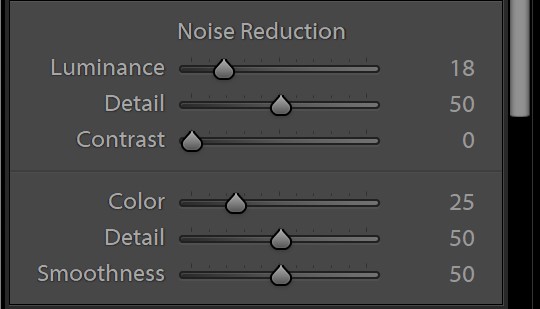
All files were exported from Lightroom using the highest level of JPG quality (100) with the least compression, with no image resizing and no additional output sharpening. Why didn’t I use TIFF? In my experience, there is no visible difference in a highest quality JPG and a TIFF. These processed images were then brought into Adobe Photoshop as full-size layers, composited for comparison, then output for web with a JPG level of 11. If nothing else, in preparing for the results, I did manage to create the largest Photoshop file I've ever worked with, at over 31GB in size. Yes, for single file.
How to Properly View the Comparisons
One final note before we get into the comparisons: these images are output to 2000px on the long side, with 1:1 pixel rendering. Be sure to click on each crop set to view the larger image. When viewed with no onscreen scaling, one pixel on your monitor will display one pixel from the camera. This is complicated somewhat by Retina-type displays that do pixel resampling. Applications like the latest versions of Photoshop and Lightroom have the option of running in non-scaled, 1:1 mode, but the pictures will appear smaller on screen.
If your monitor resolution is less than 2000px across, like on an iPad or a laptop, be sure to right-click on the image and select Open link in new tab (be sure to select link not image). This will open just the image, allowing you to view it at the correct size once you click to magnify. Or, even better, right-click to Save link as… and view in Photoshop. Unfortunately, with technological innovation comes its own set of challenges. Retina and 4K/5K displays look stunning, especially for text, but are sometimes less than ideal for image comparisons as they employ pixel doubling and no longer show 1:1.
M Cameras Compared: M10 Monochrom vs. M Monochrom (Typ 246) vs. M10-P
For this M-System matchup, we're comparing the new M10 Monochrom, the previous generation M Monochrom (Typ 246) and the M10-P, with its color file converted to black and white. As I stated above, the M10 Monochrom's 41 megapixel files have been downsampled to 24 megapixel, matching up to the other two. For more explanation on my reasoning, please see the resolution section above. If you want to see the resolution difference you can scroll past the 3-way comparisons, and I have a native resolution match-up between the M10M and the M246.
ISO 200
To start things off, we've got all the M cameras at low ISO. While the base ISO of the M10M is ISO 160 and the M10-P is ISO 100, the M246 doesn't go below ISO 320. So, 200 for the newer cameras and 320 for the previous Monochrom is a bit of a compromise. And really, there is no visual difference. All are exceptionally good.
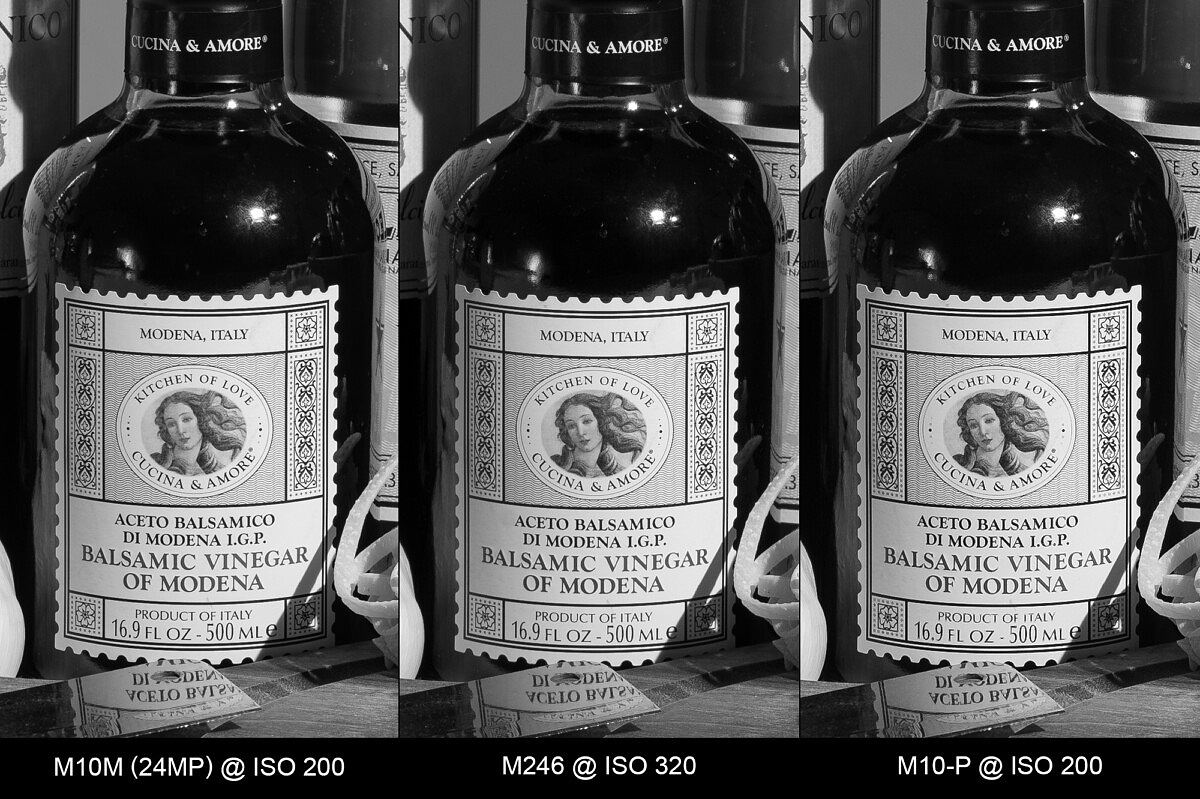
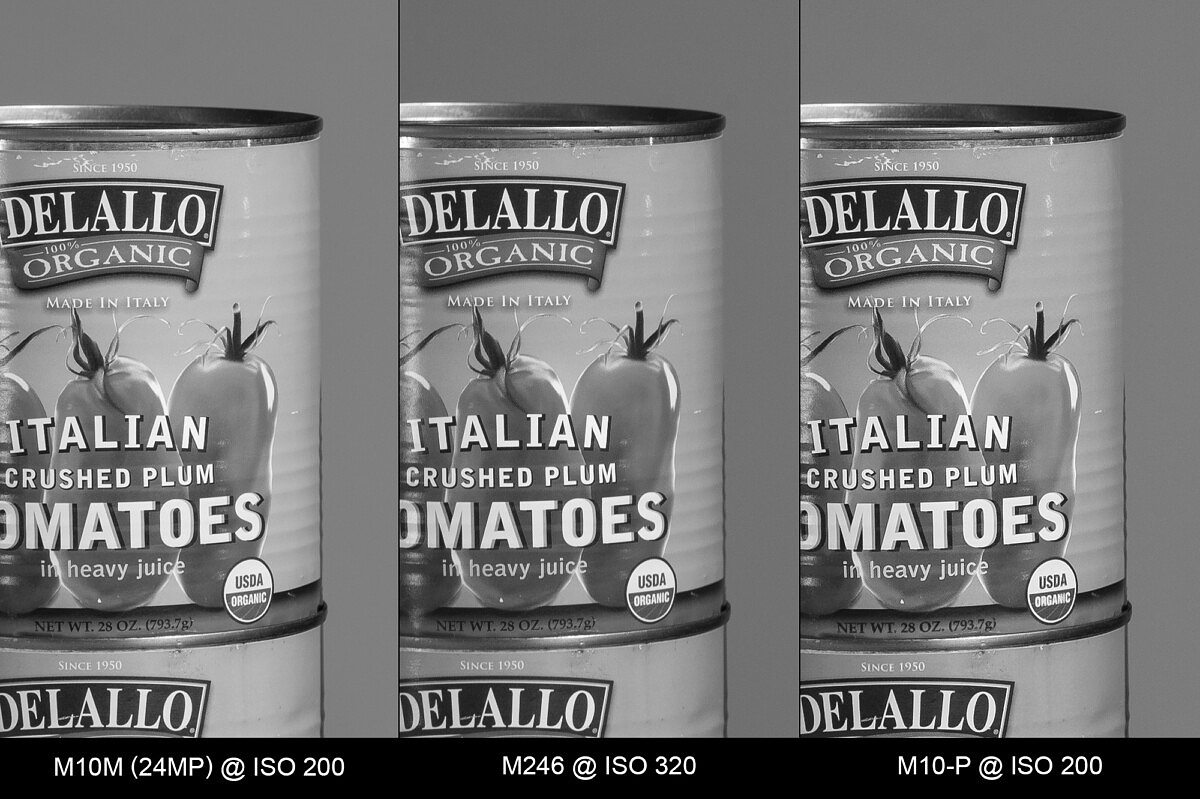

ISO 400
At ISO 400, all are still perfect. Detailed, smooth.


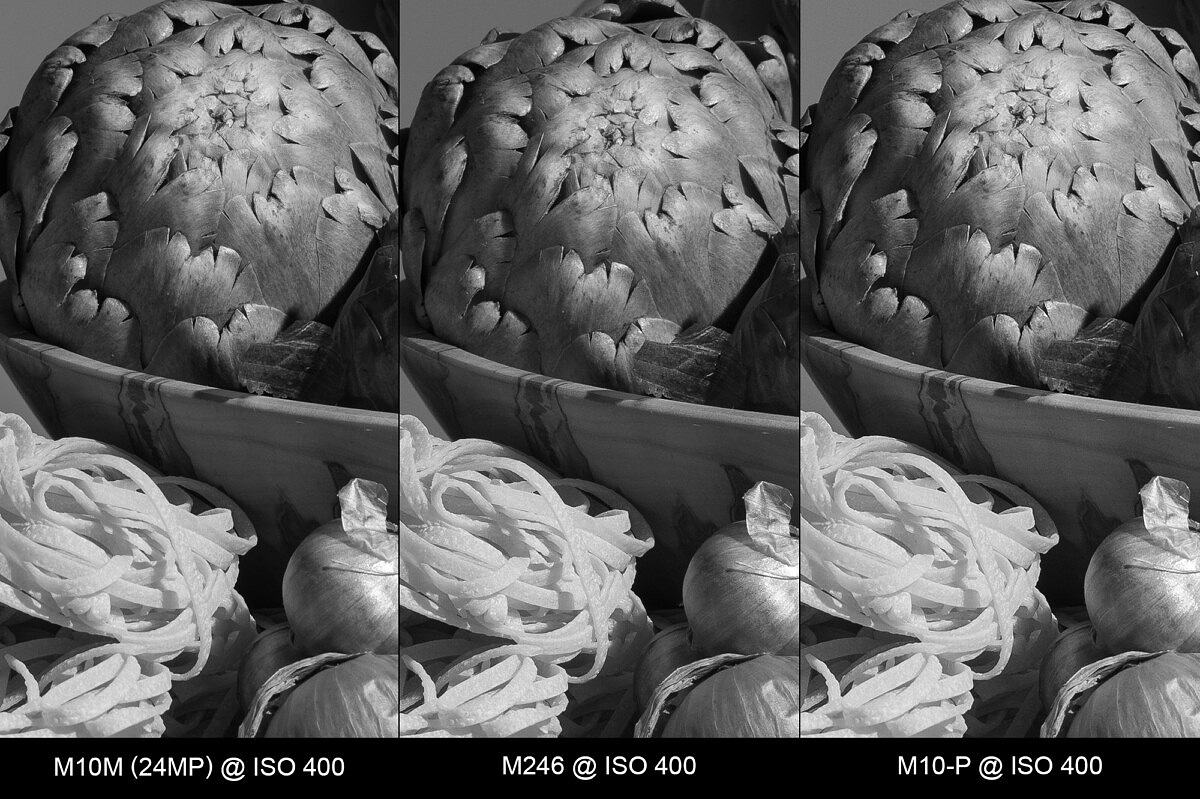
ISO 800
Same story at ISO 800. Almost no discernable loss of quality for any of the M cameras.

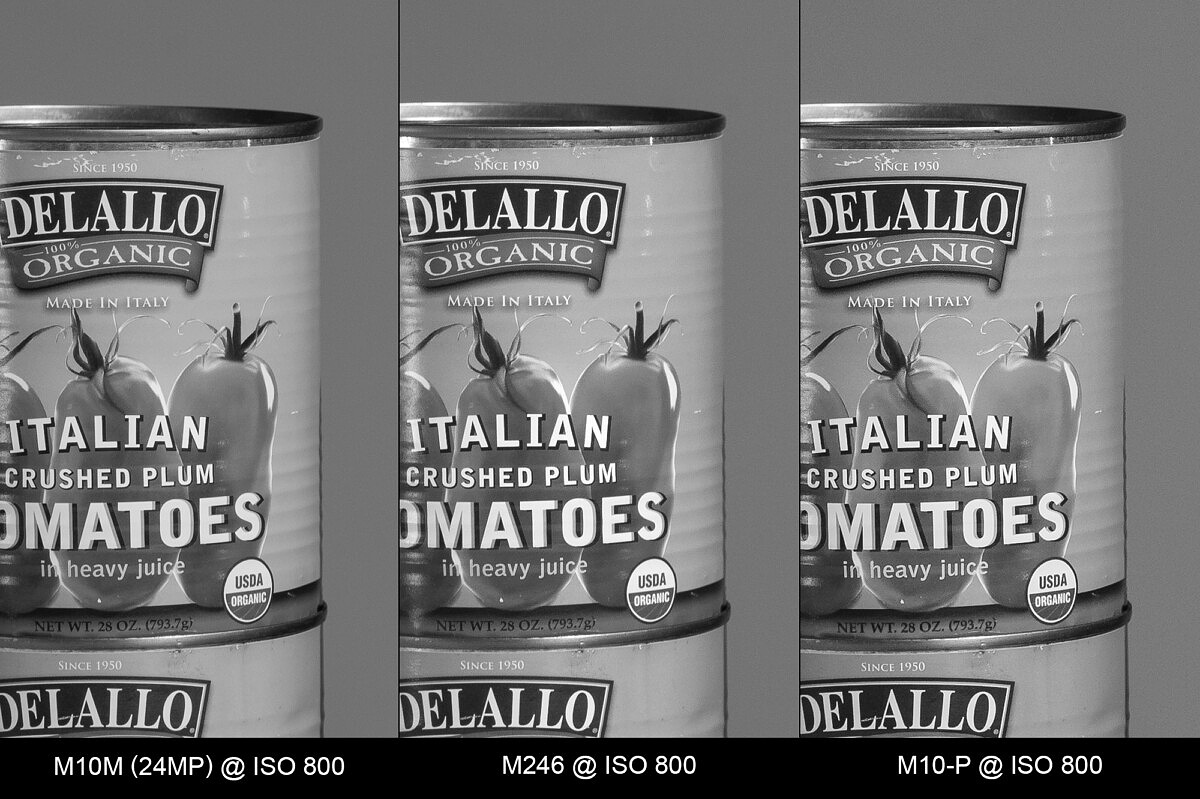
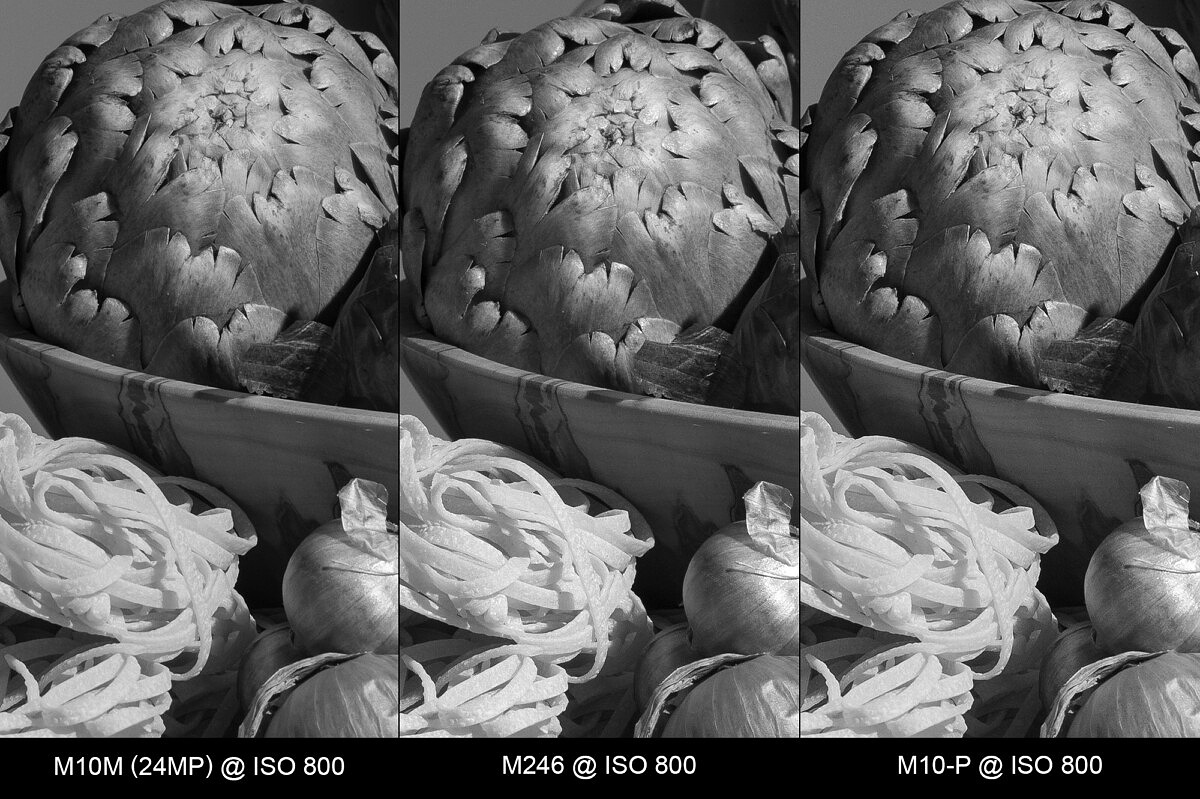
ISO 1600
Just the tiniest amount of noise is starting to be visible in the background. Interestingly, the M246 is the smoothest here.
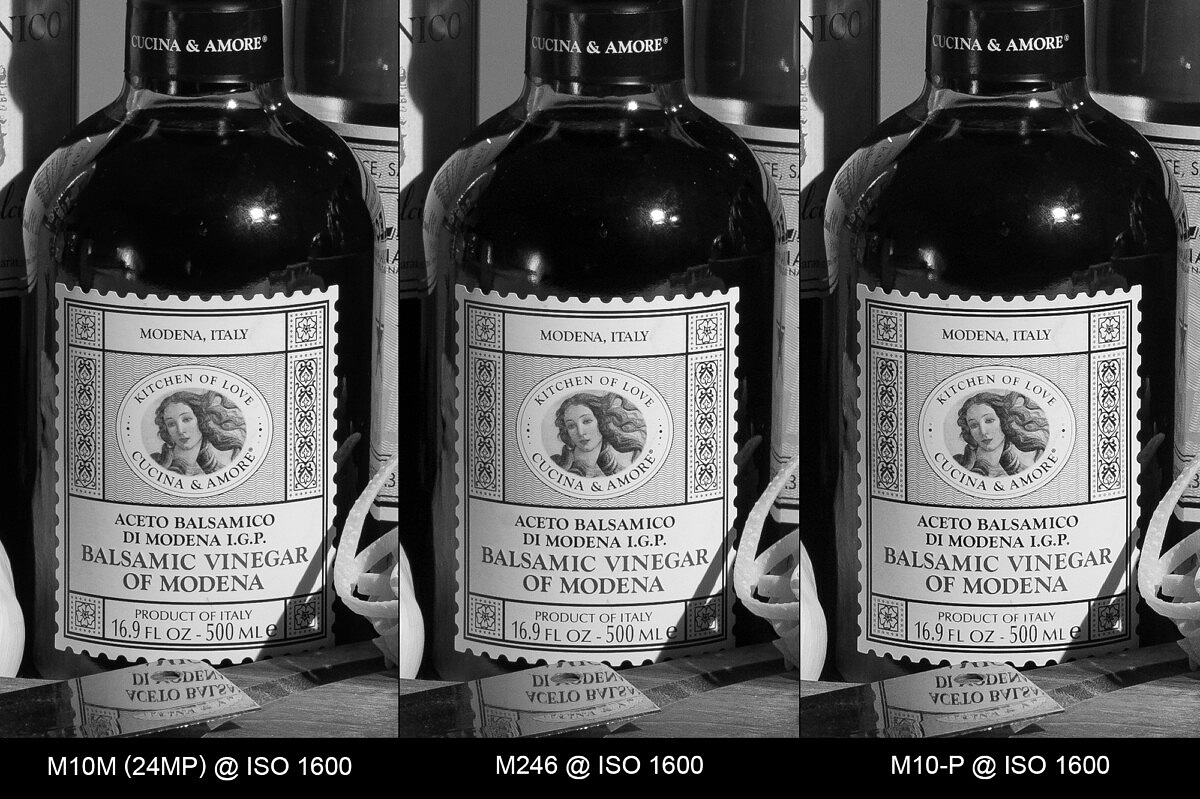
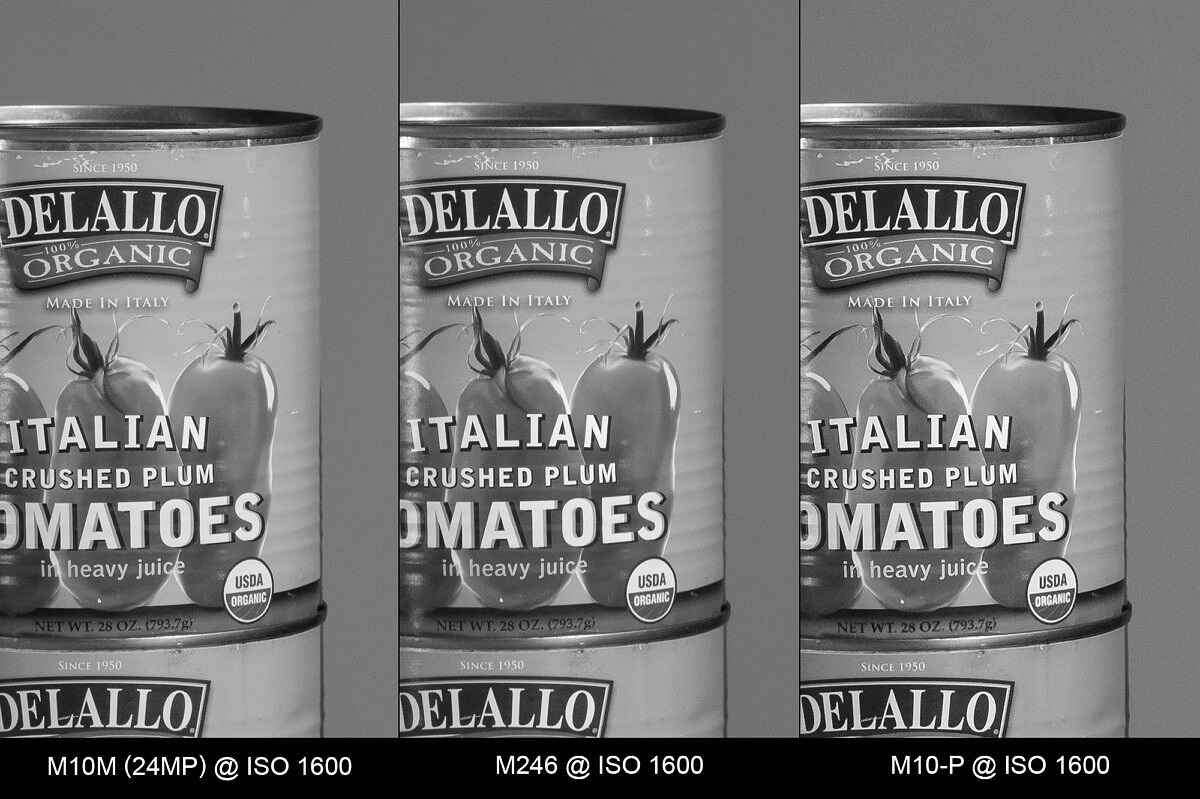
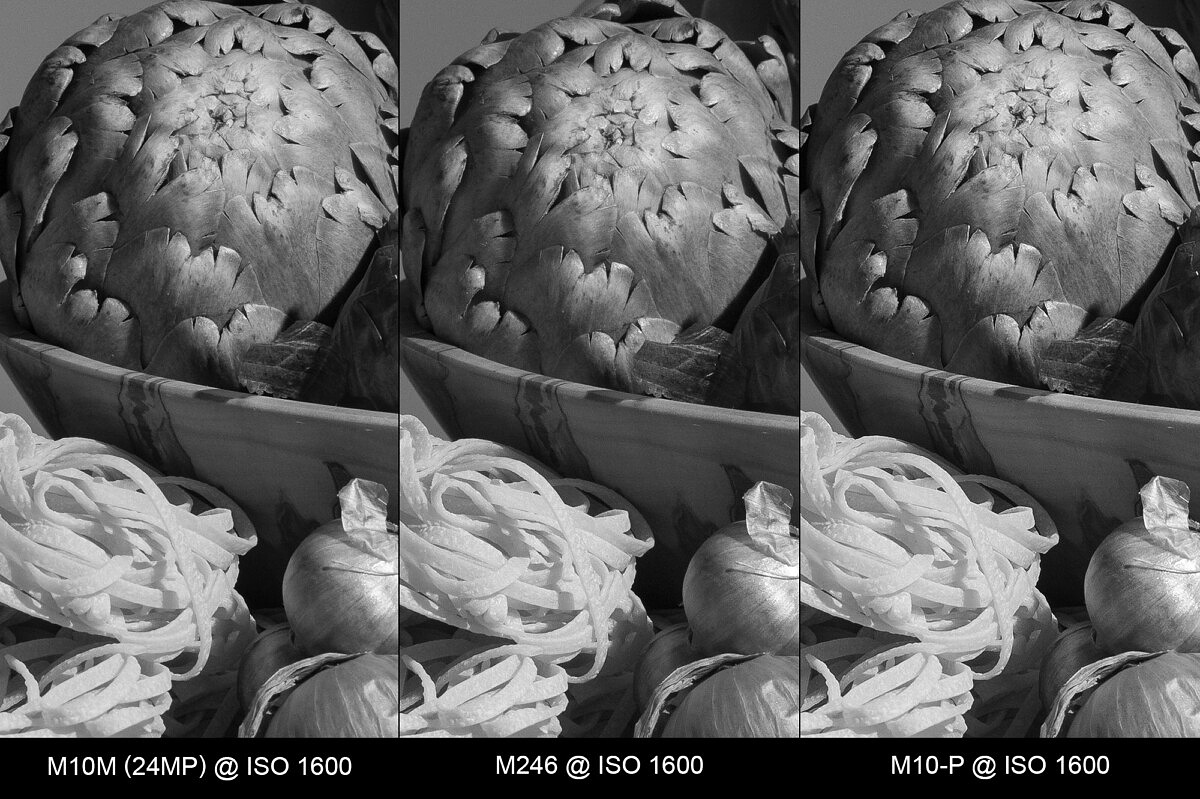
ISO 3200
One stop higher and the advantage seems to have shifted to the M10M's favor. Detail resolution and overall crispness looks just a bit better than on the M246, but still, the differences are minor.
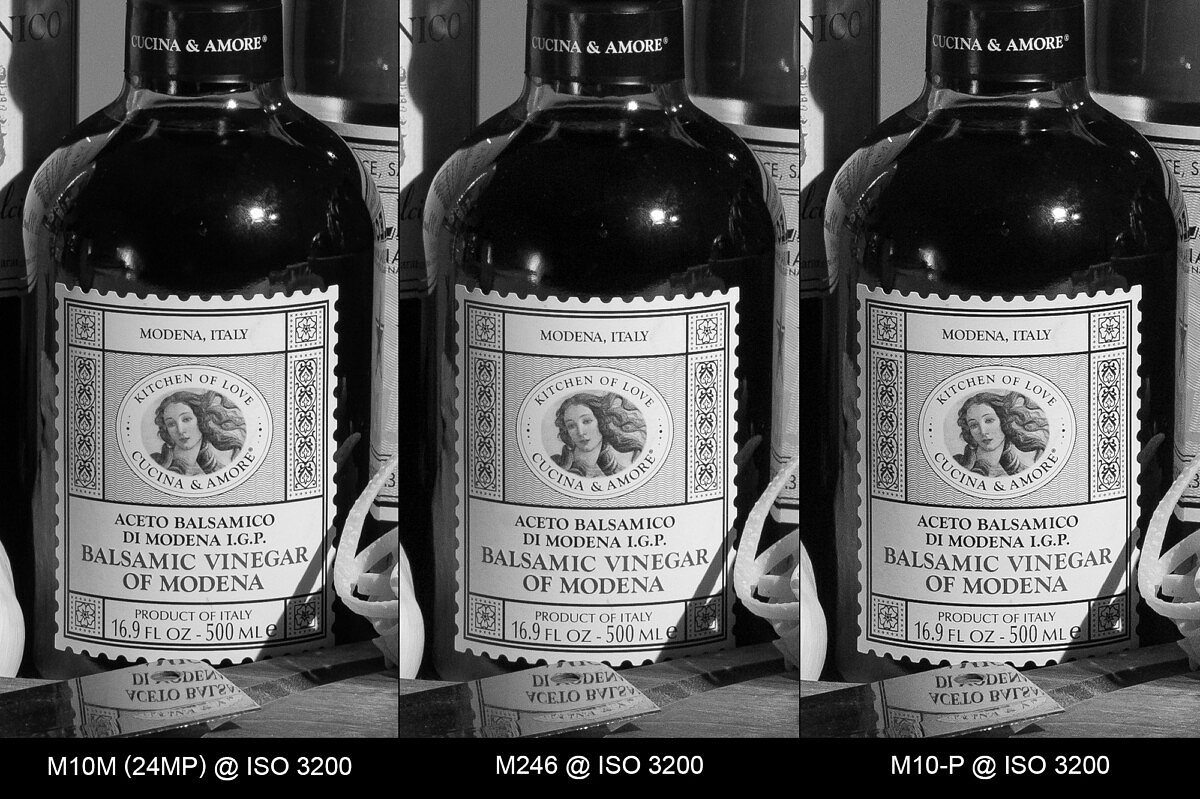


ISO 6400
All the M cameras are doing really well here. Both Monochroms are still roughly on par, with the M10M continuing to resolve more detail. The M10-P is just starting to fall off from the other two.


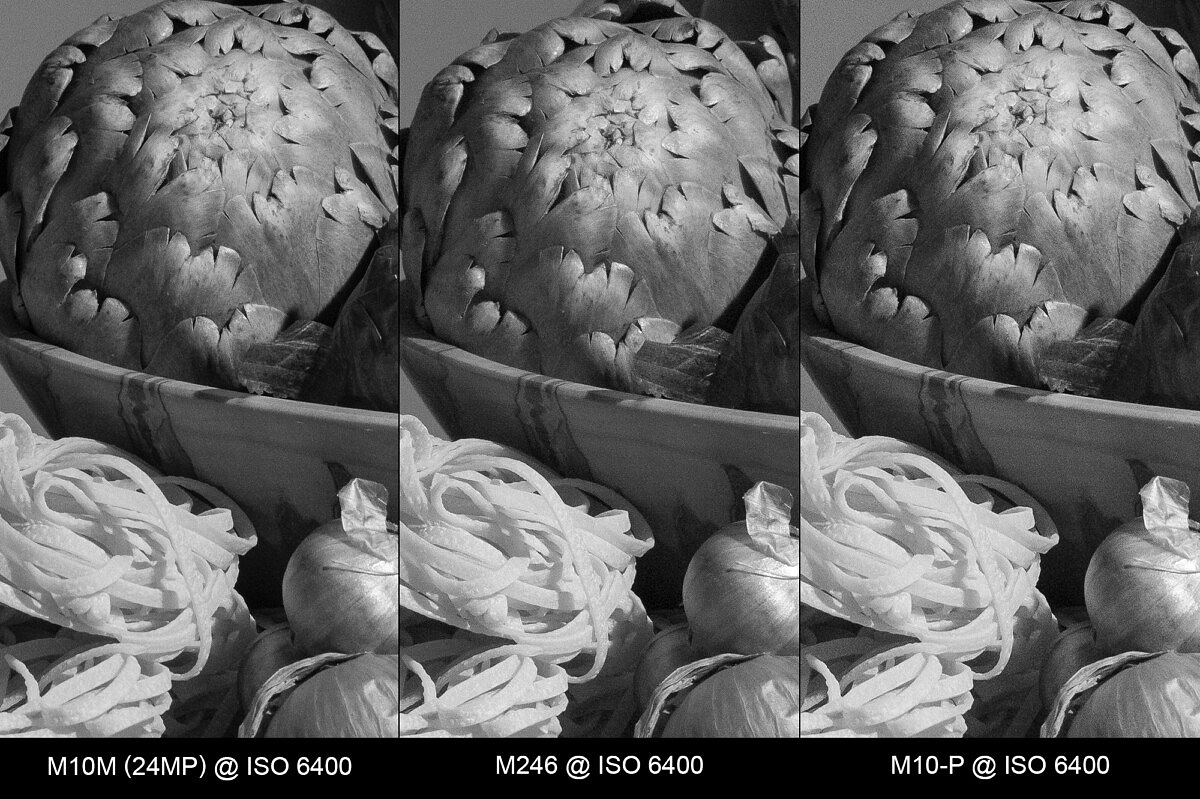
ISO 8000
Let's slow things down a little. Instead of whole stops, we'll evaluate at 1/3 stop increments. The image quality will degrade much quicker now, so it's good to really get a feel for the limits on each camera.
At ISO 8000, noise is tightly packed for all cameras, but more visible on the M10-P. The M10M is very slightly in the lead.

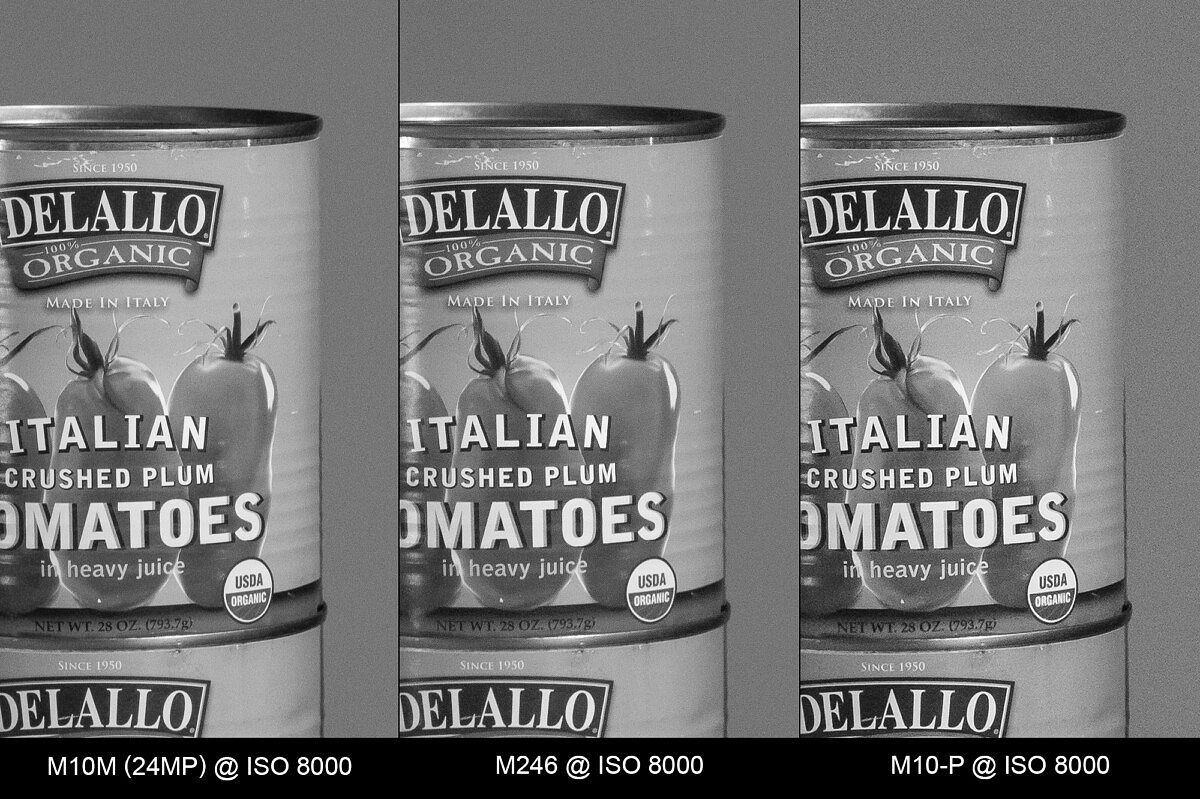

ISO 10000
The M246 appears to overtake the M10M with slightly less noise, but at the expense of some detail. And while the M10-P is picking up incrementally more noise, details are still sharp.
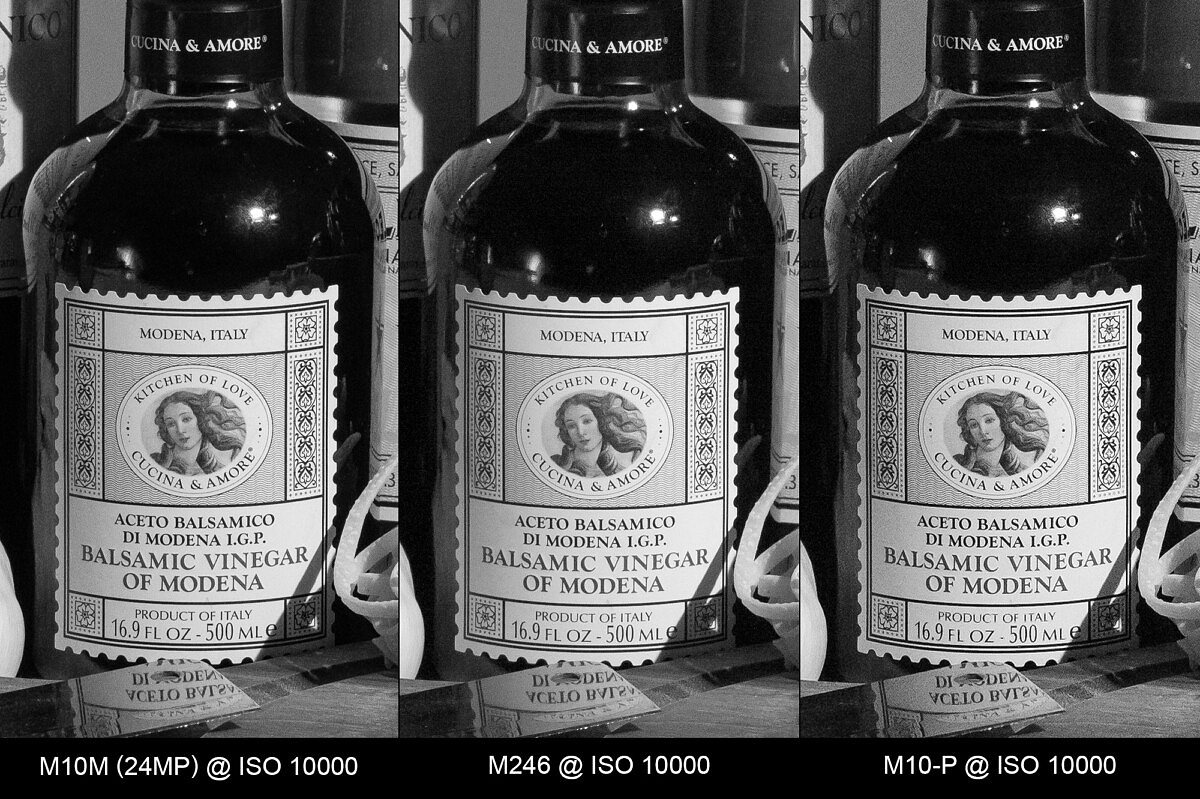

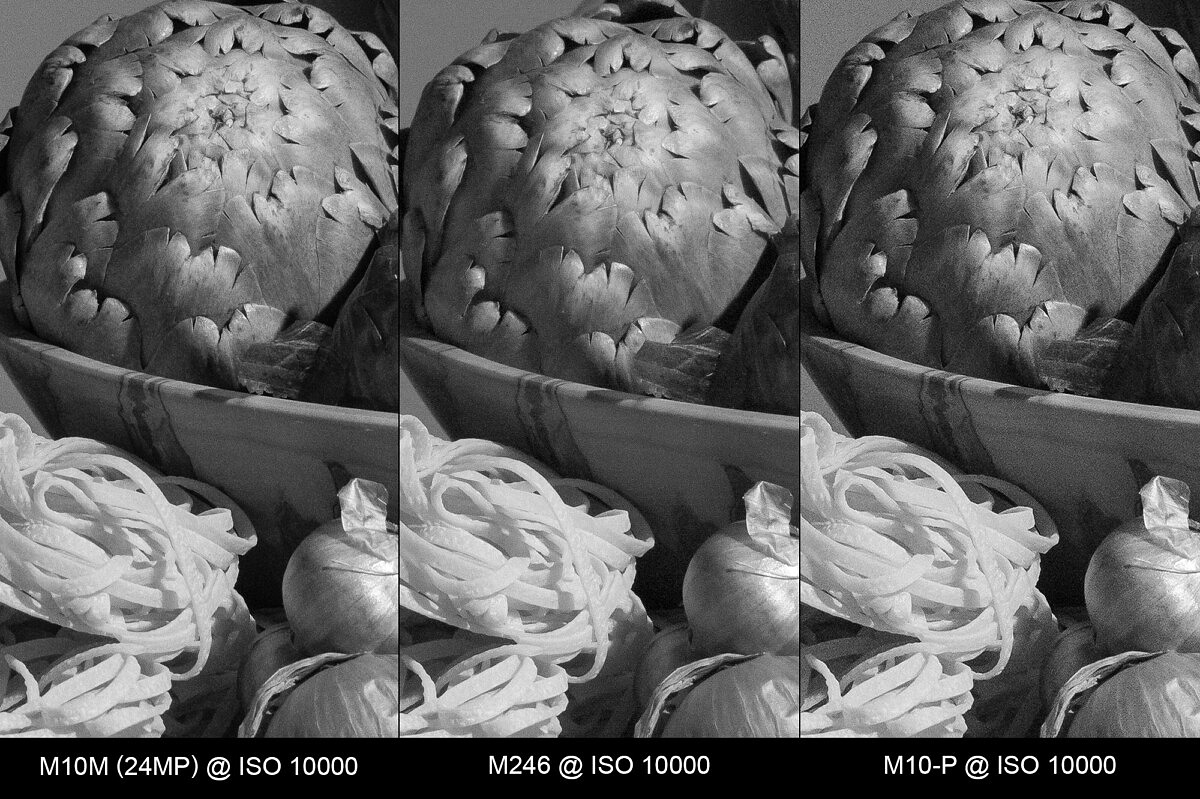
ISO 12500
Almost the same story as ISO 10000, but the M246 seems even better. Could the older M246 actually be besting the newer M10M?

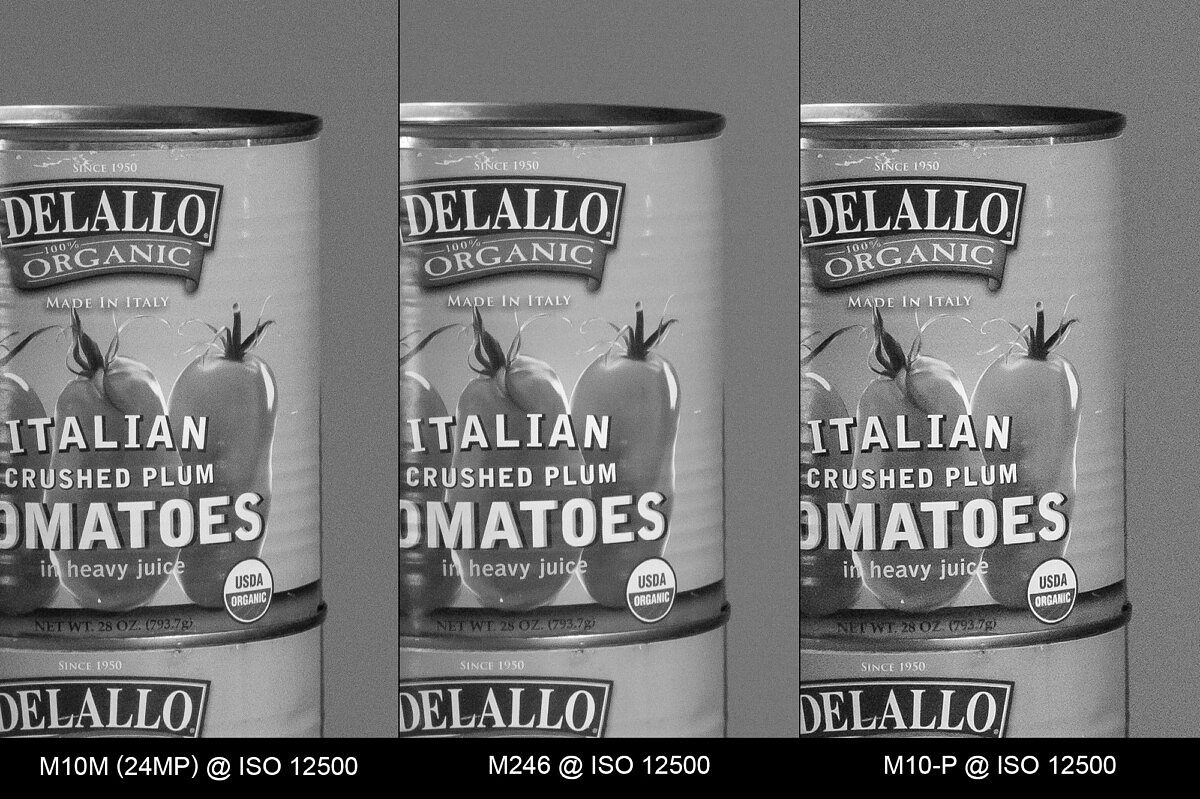

ISO 16000
Unfortunately, the M246 has no 1/3 stop increments between ISO 12500 and 25000, so for 16000, we'll compare the M10M and M10-P to the M246 at ISO 12500.
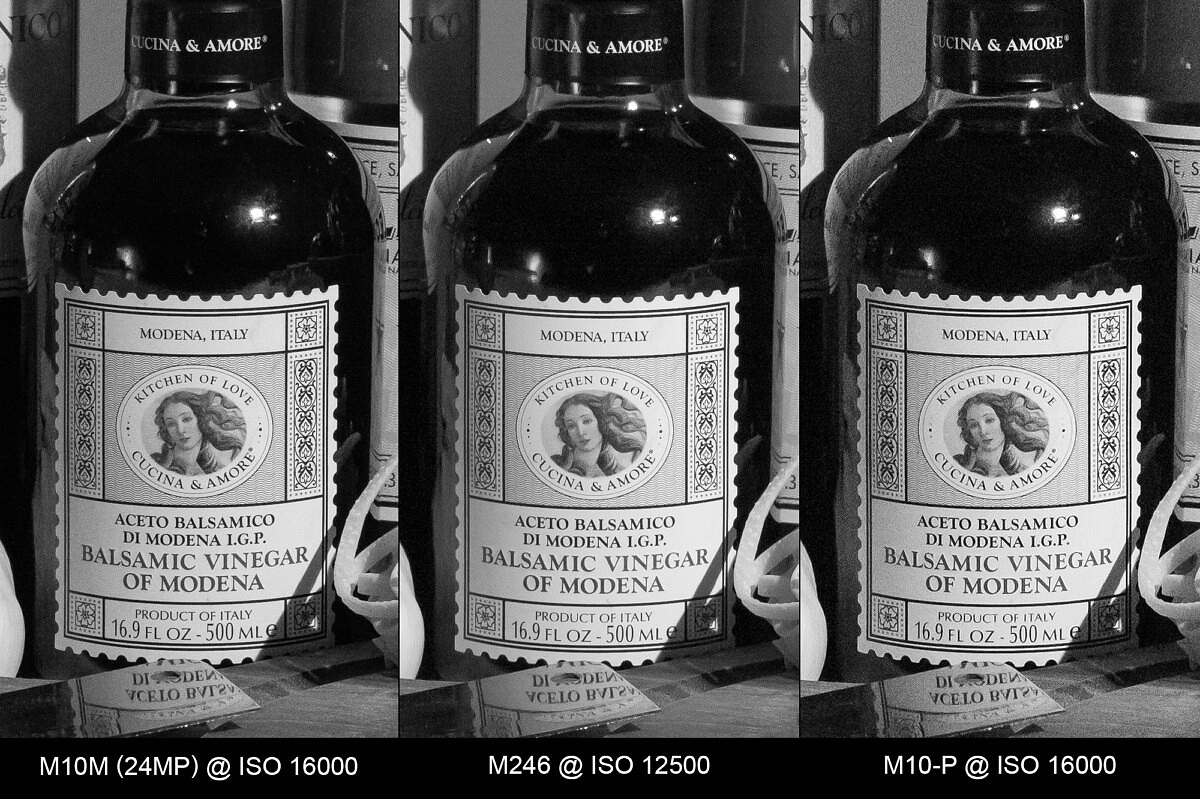
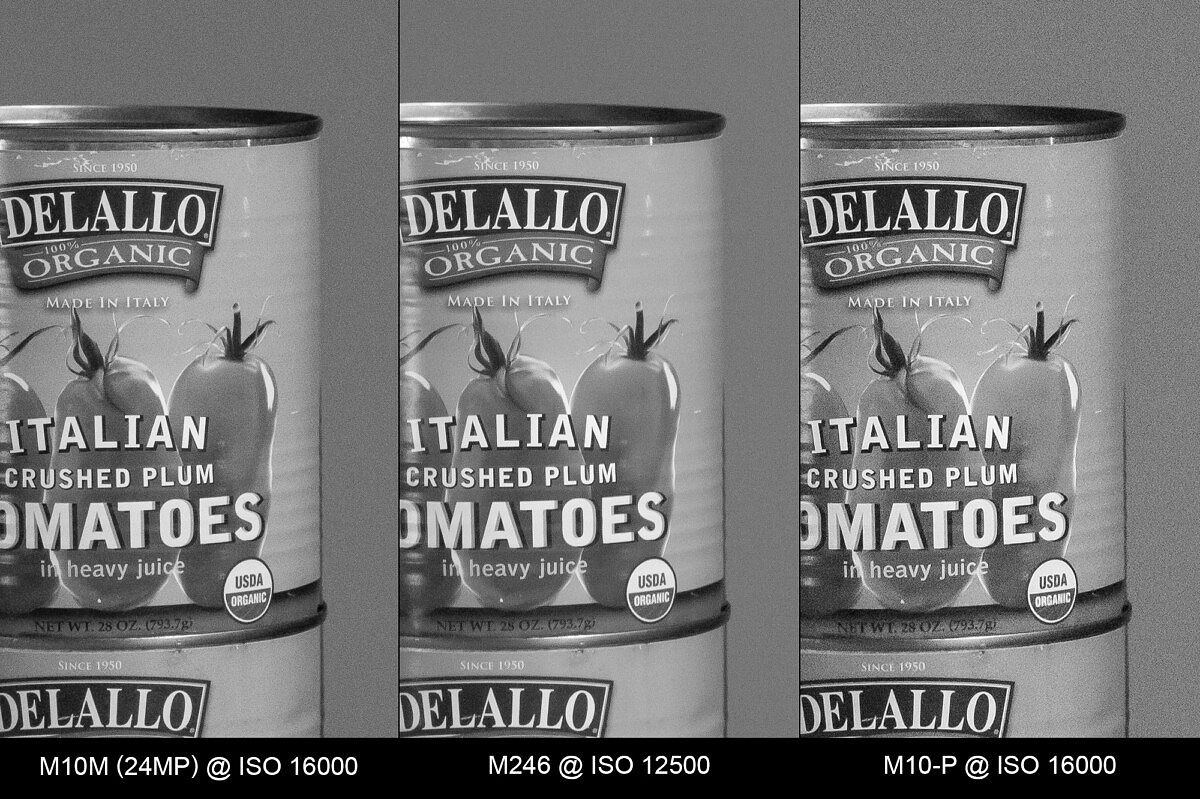

ISO 20000
Just as in the last match-up, at ISO 20000, we have to compare to the M246 at ISO 12500. The M10M seems to be holding steady, but the M10-P seems to be displaying more noise.
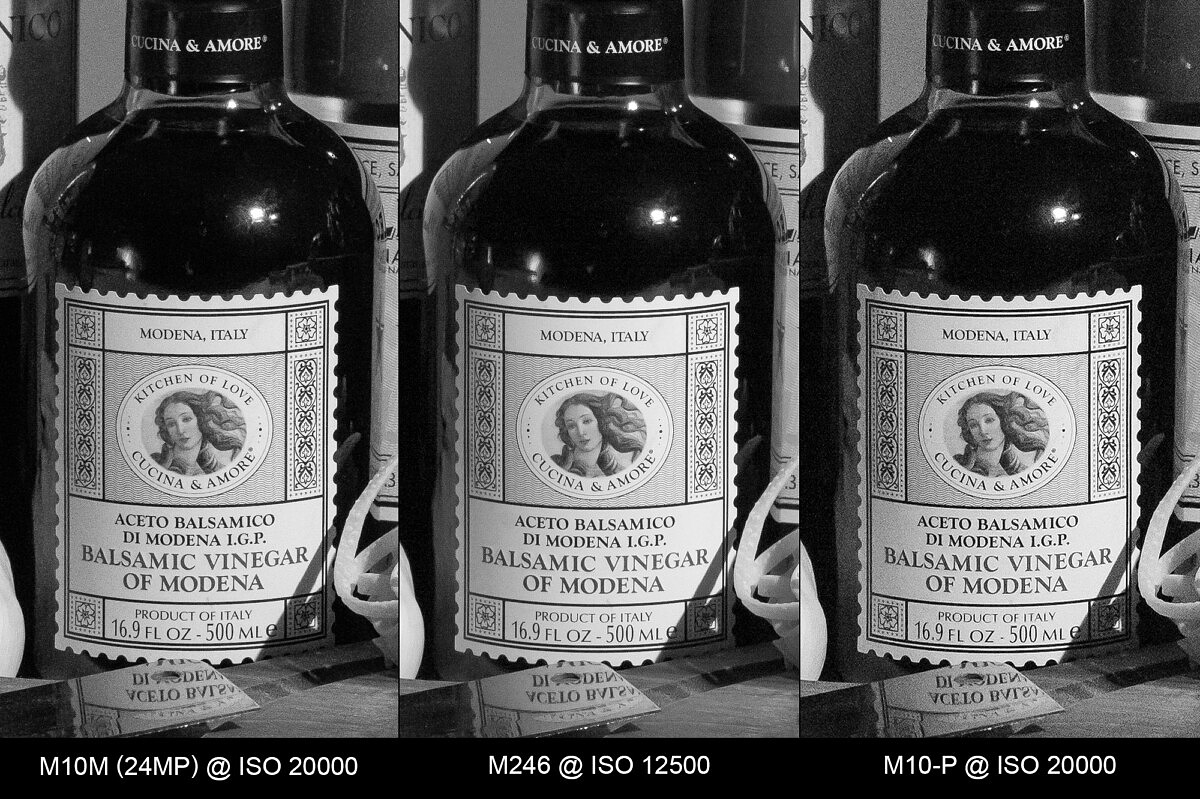


ISO 25000
We've hit the top of the ISO range on the M246, but still have one more stop on the M10-P and two stops more on the M10 Monochrom. From here on out, the max 25000 setting will be displayed for the M246. This will help us see how much improvement the M10 Monochrom actually has.
Now, we're starting to see some really interesting differences in how these cameras perform near or at their limits. The M246, while still exhibiting a very clean image, is doing so at the expense of detail. Image contrast has also dropped, resulting in a dull appearance. The M10-P, on the other hand, is maintaining contrast and detail, but at the expense of more pronounced noise. The M10M takes the best of both, with low noise and amazing detail clarity.
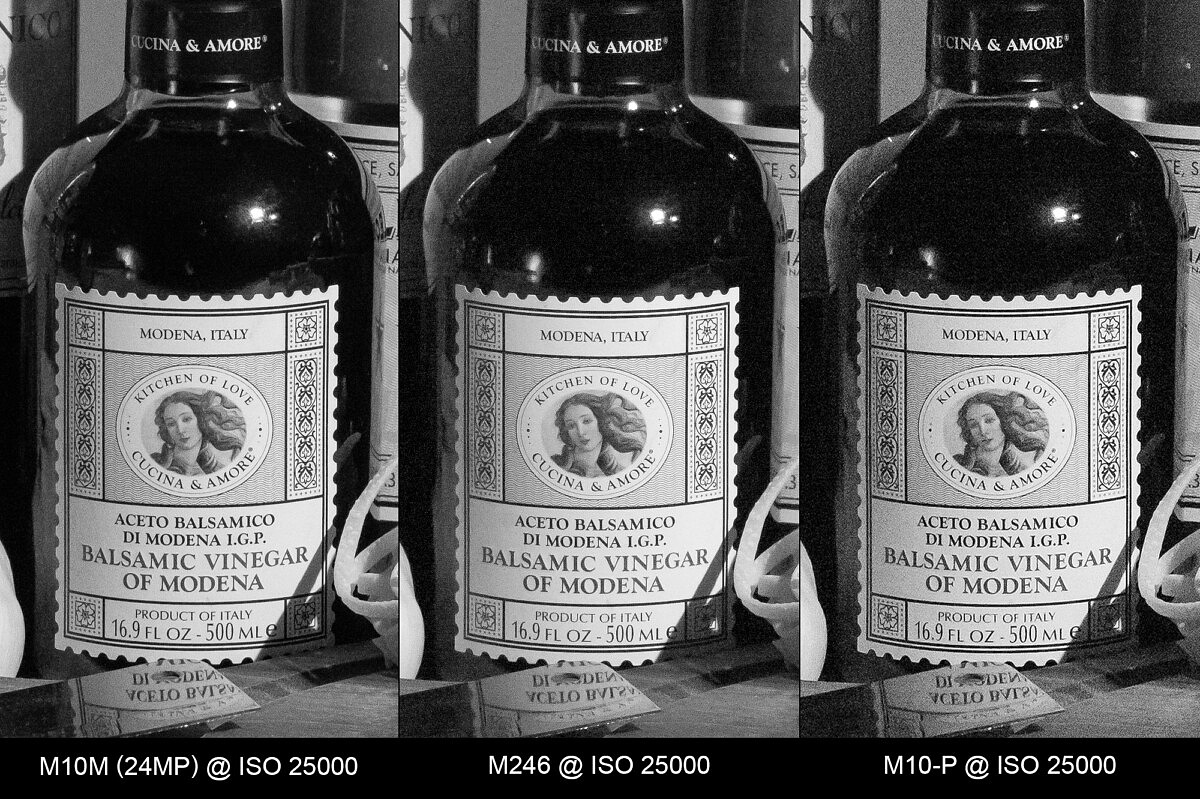


ISO 32000
The M10 Monochrom still looks great at ISO 32000, even compared to the M246 at ISO 25000. The M10-P seems to have more left but is getting very noisy compared to its Monochrom cousins.


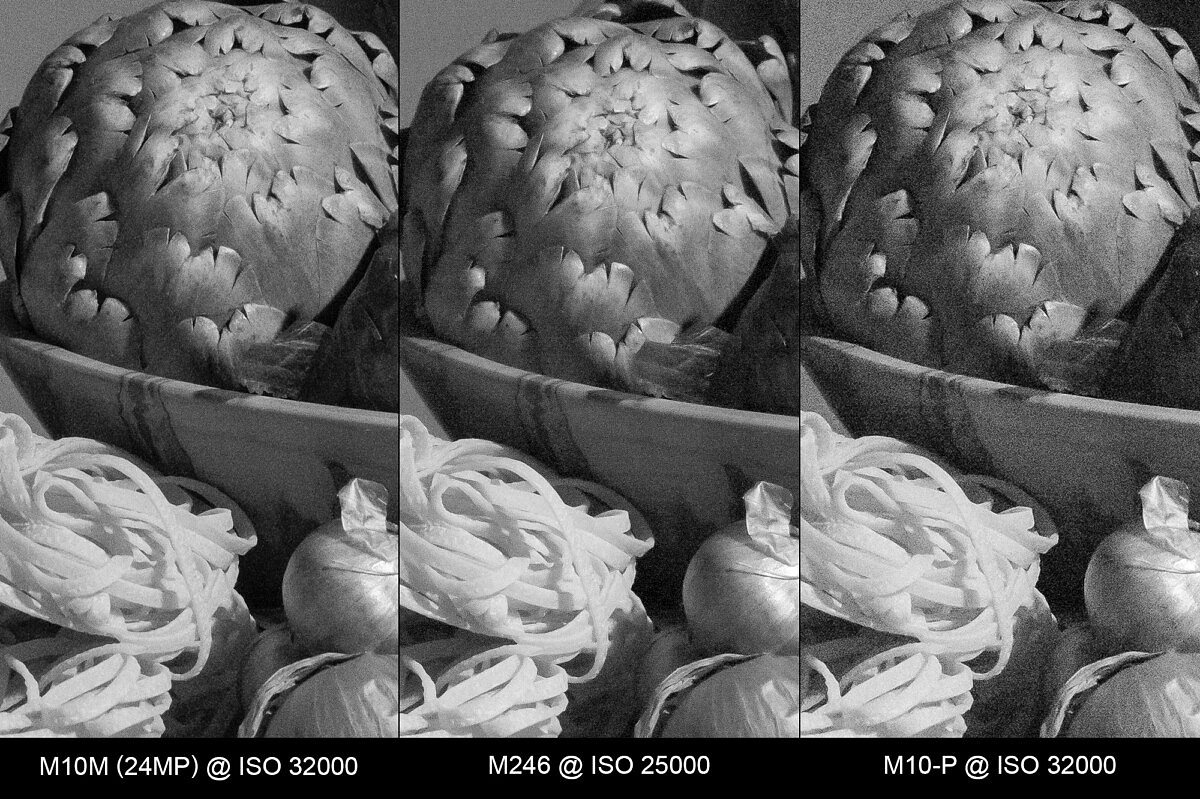
ISO 40000
Now, we're finally starting to see the M10M pick up some noise, but detail resolution is still excellent, better than the M246 at ISO 25000. Noise is now quite significant on the M10-P.


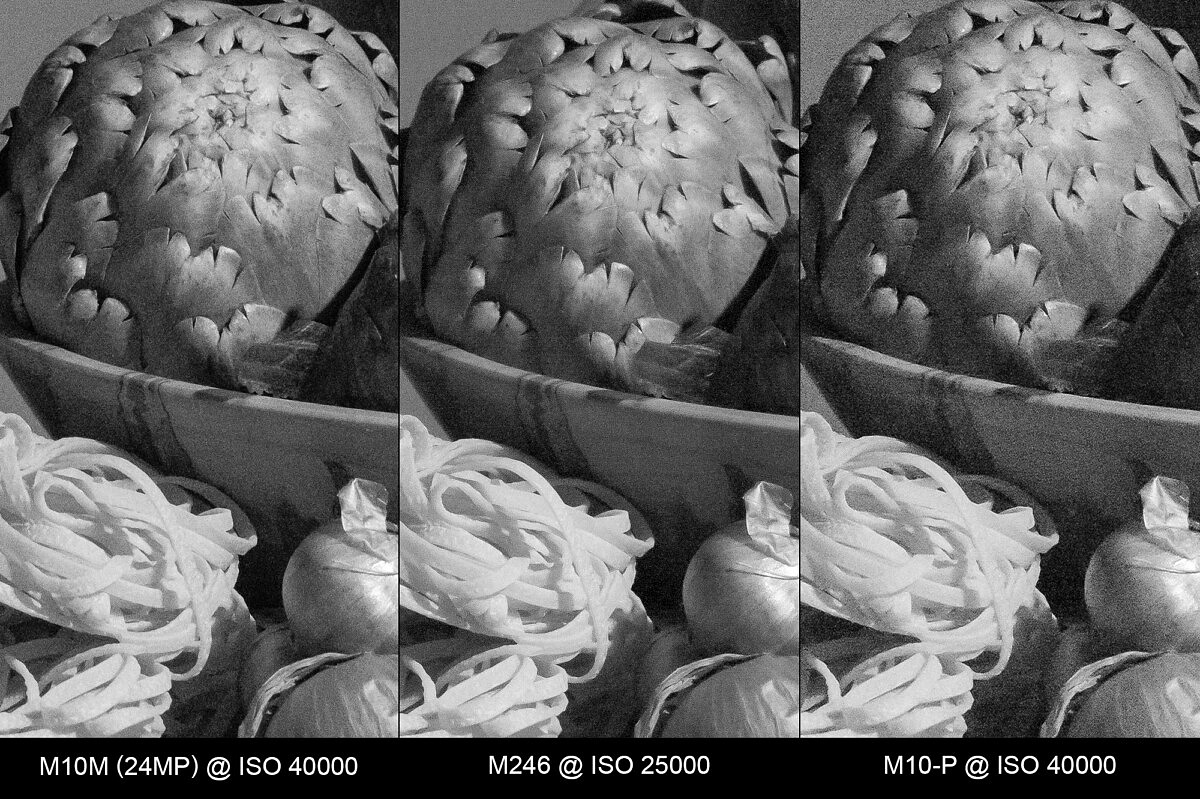
ISO 50000
At ISO 50000, we've hit the upper limit on the M10-P. The M246 is a full stop behind at ISO 25000 and the M10M still has another stop in the tank. Really impressive showing by the M10M as the noise:detail ratio seems to hold fairly steady.



ISO 64000
At ISO 64000, we've ventured past the native ISO ranges of both the M10-P and the M246, but the M10M keeps on going strong.


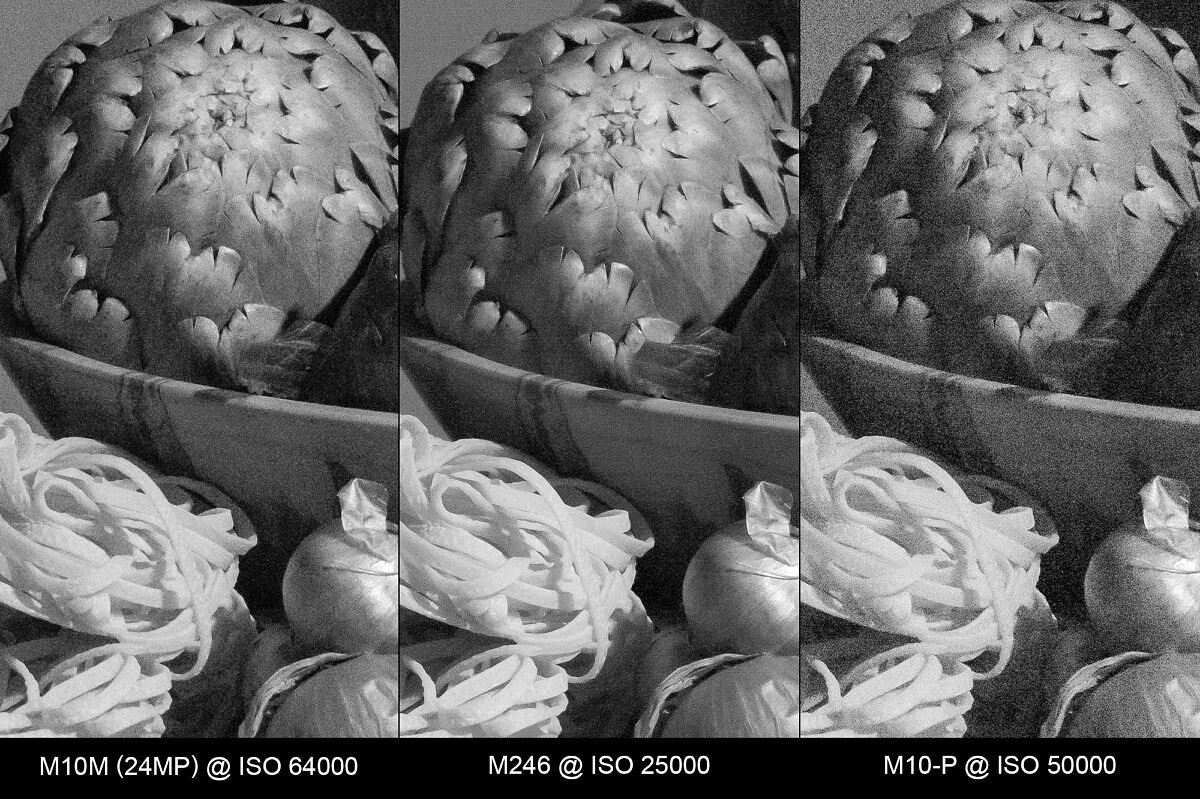
ISO 80000
The M10M image is picking up more noise and losing some midtone and shadow detail, but high frequency info is still retained.
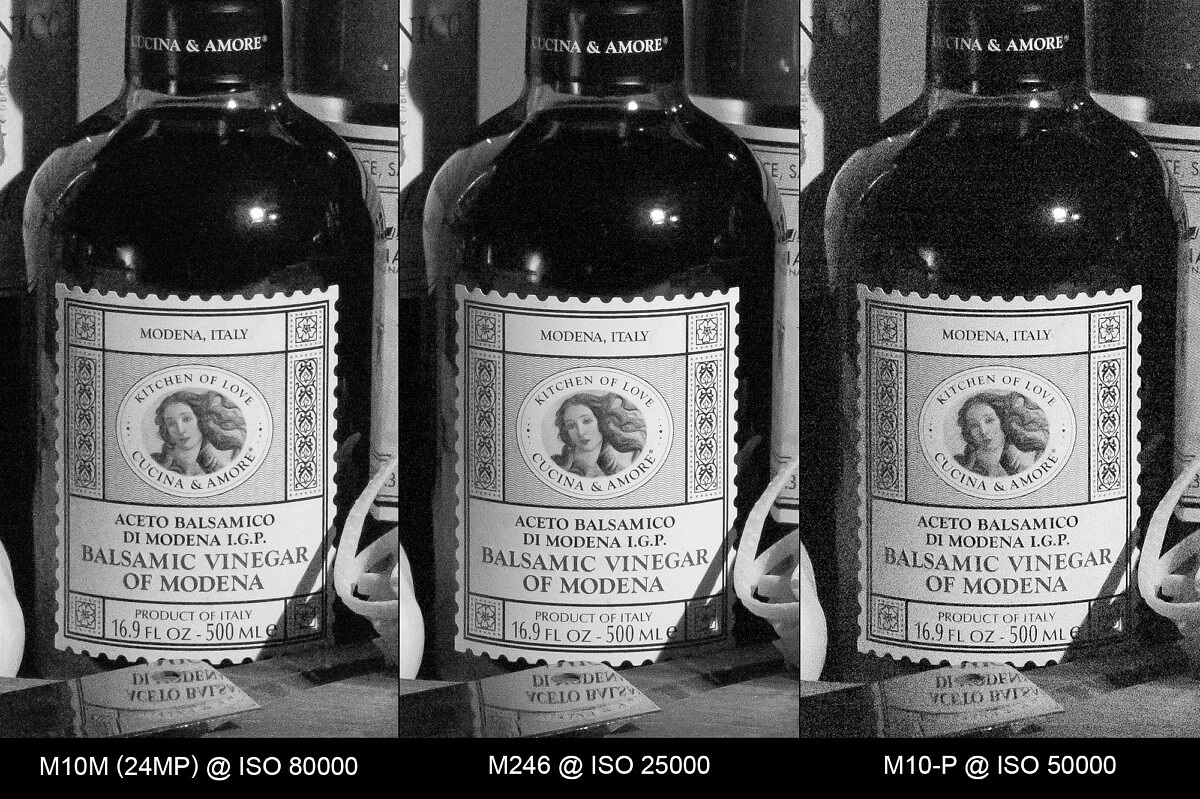


ISO 100000
At 100000, the M10M is at the top of its ISO range, a full stop faster than the M10-P and two stops more than the M246. It's noisy, but the pattern is tightly packed and uniform. There's still usable detail and ISO 100000 looks better than 50000 on the M10-P.

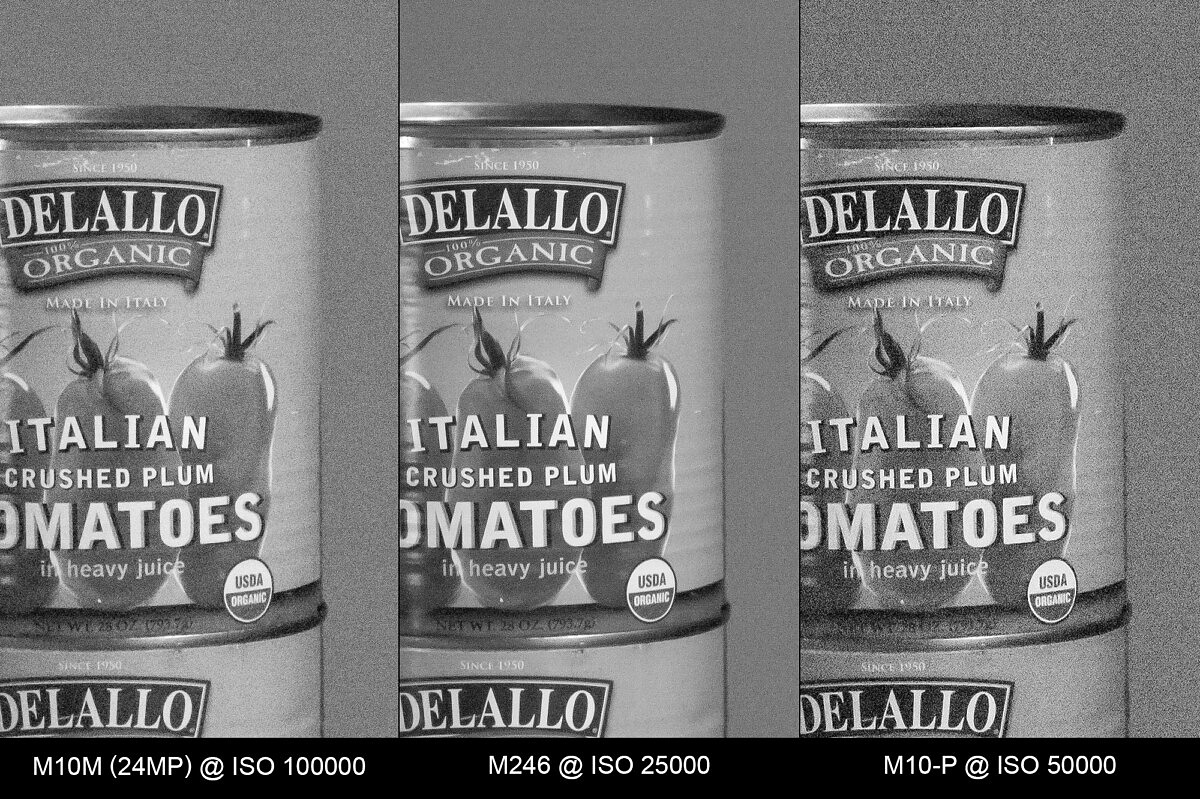
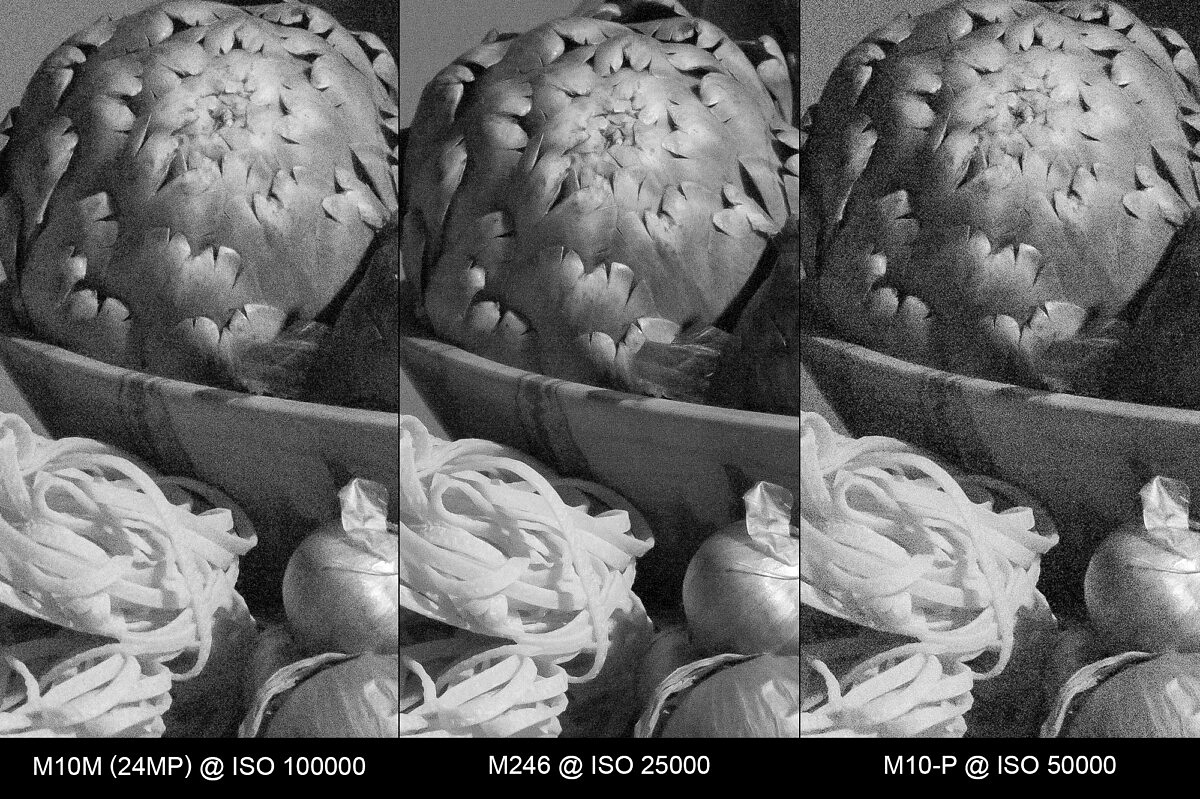
Best of High ISO Settings
For this bonus set, I've combined the three cameras at the ISO values I felt displayed the greatest amount of detail before exhibiting noticeable noise. The M10-P isn't too far behind the M246 at ISO 10000 versus ISO 12500. But the M10M shows its capability at ISO 32000. The M10M does show more noise in the background, but a bit more noise reduction in Lightroom could work very well here.
Basically, what we're seeing is a 1.5 stop advantage of the M10M, but this is a bit of an oversimplification. The M10M maintains similar image quality across an even wider range of ISO values, almost plateauing once hitting ISO 10000.



Native Resolution Comparison: M10M vs M246

If you found flaws in my logic for downsampling the M10 Monochrom, or simply wanted to see the actual resolution increase over the M Monochrom (Typ 246), I've got you covered with this next comparison set. Just for the sake of slightly minimizing the amount of images in one post, I've limited these comparisons just to the central balsamic vinegar bottle and pasta.
Here, I decided to include the respective base ISO results from each of these two Monochrom cameras, ISO 320 for the M246 and ISO 160 for the M10M. Honestly, there is no visual difference from the earlier method.
Having already covered the basic analysis above, I'll simply leave these here for you to draw your own conclusions. Suffice it to say, while both cameras resolve an incredible amount of detail and textural nuance, the M10M's large pixel advantage serves it well here. You can easily see the added detail throughout the whole test range.
Base ISO (160 vs. 320)

ISO 400

ISO 800
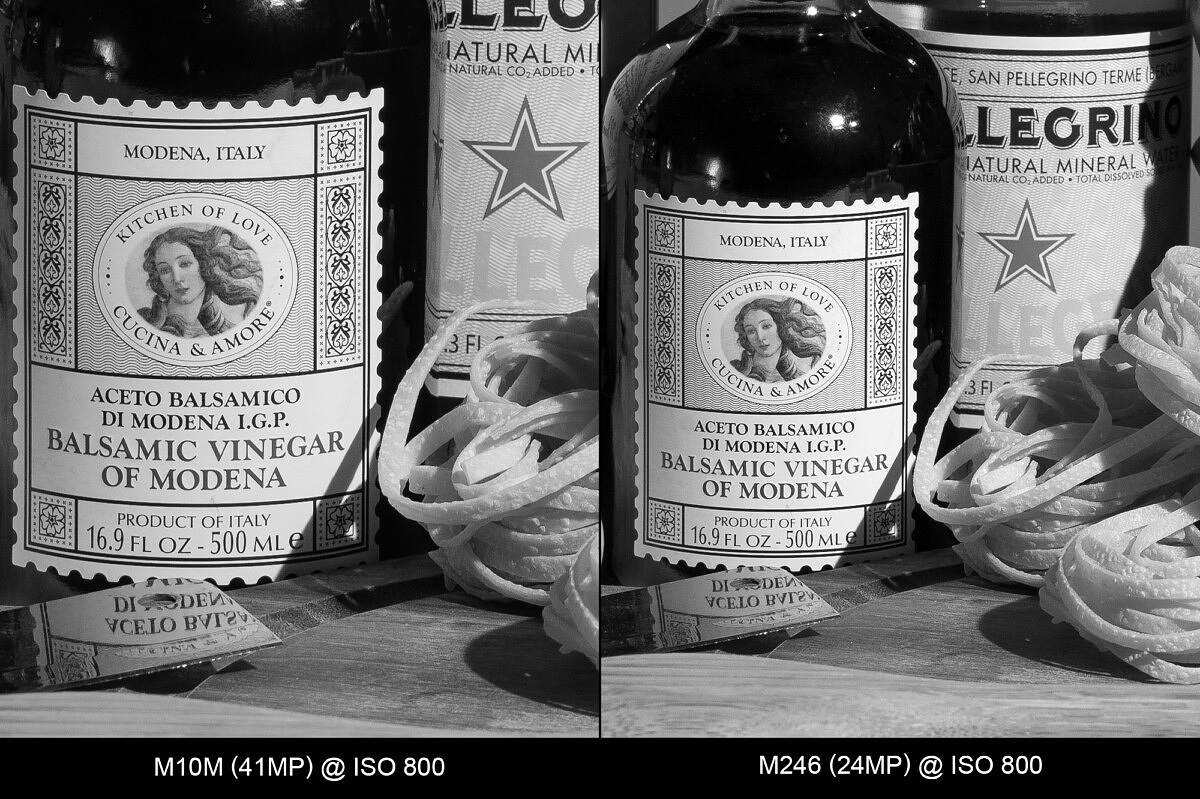
ISO 1600

ISO 3200
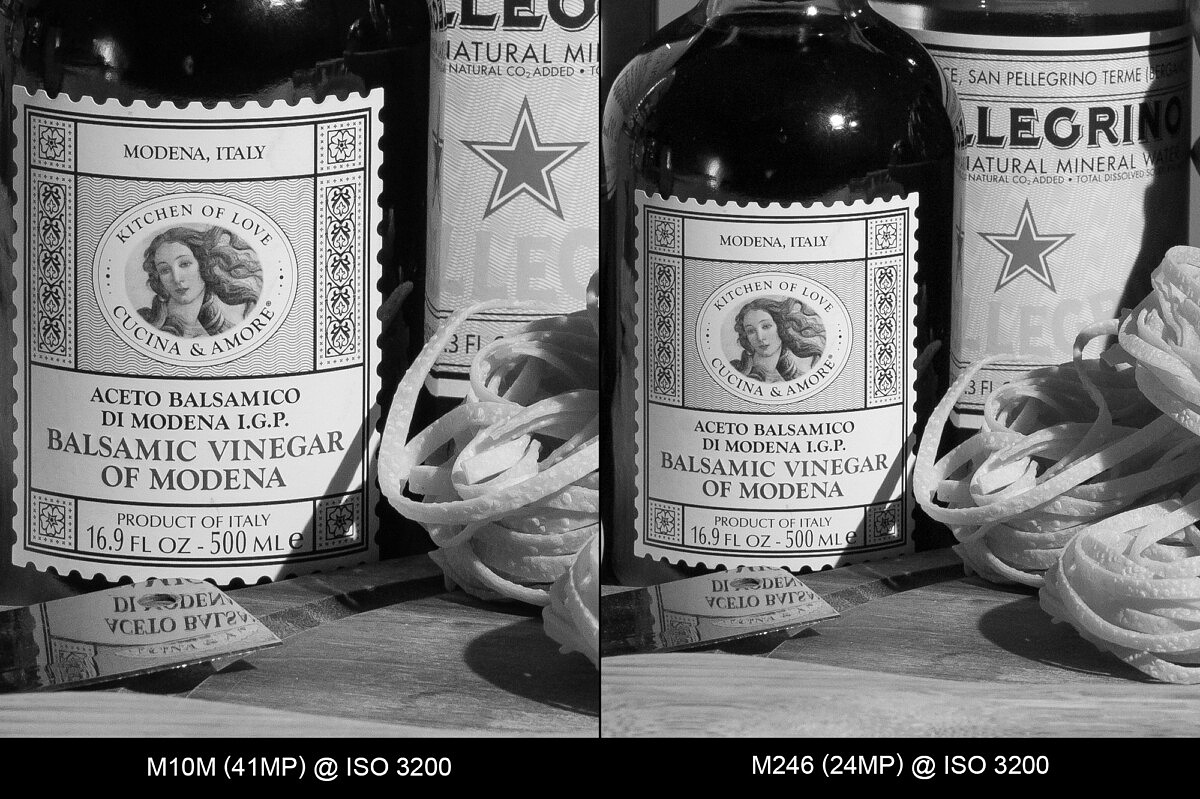
ISO 6400

ISO 8000
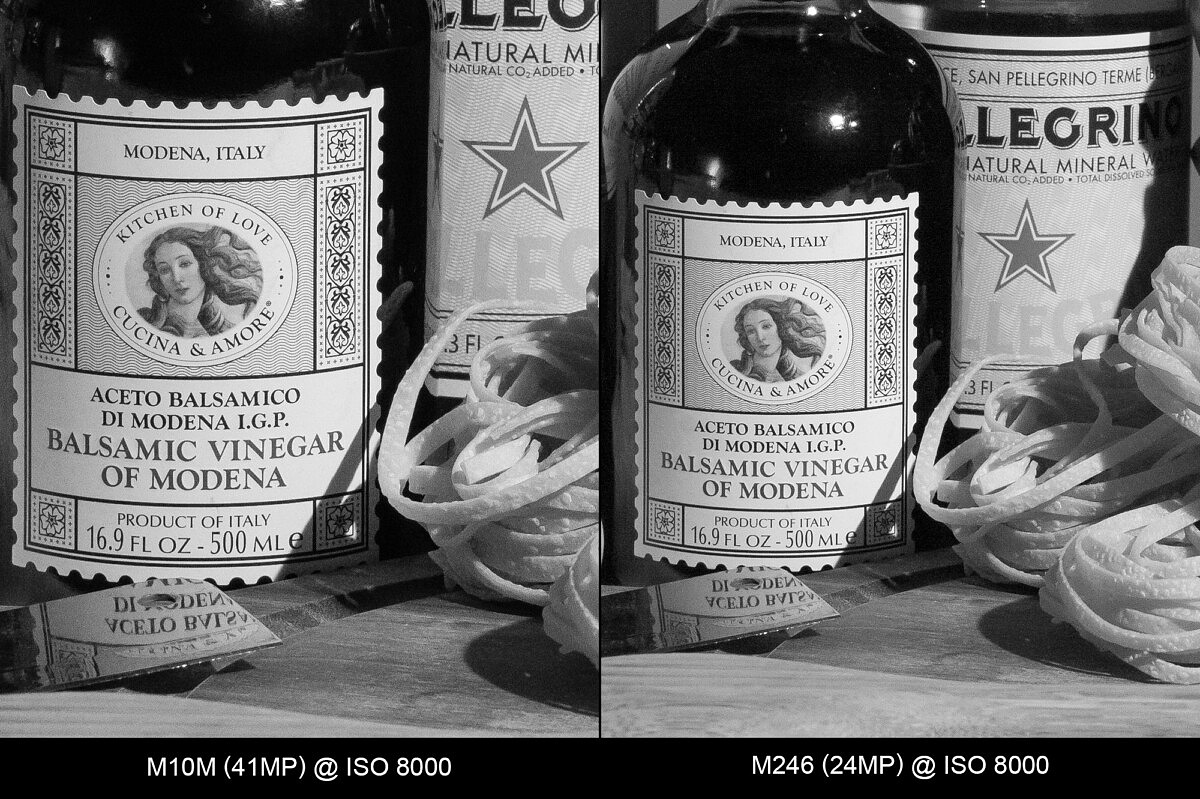
ISO 10000

ISO 12500
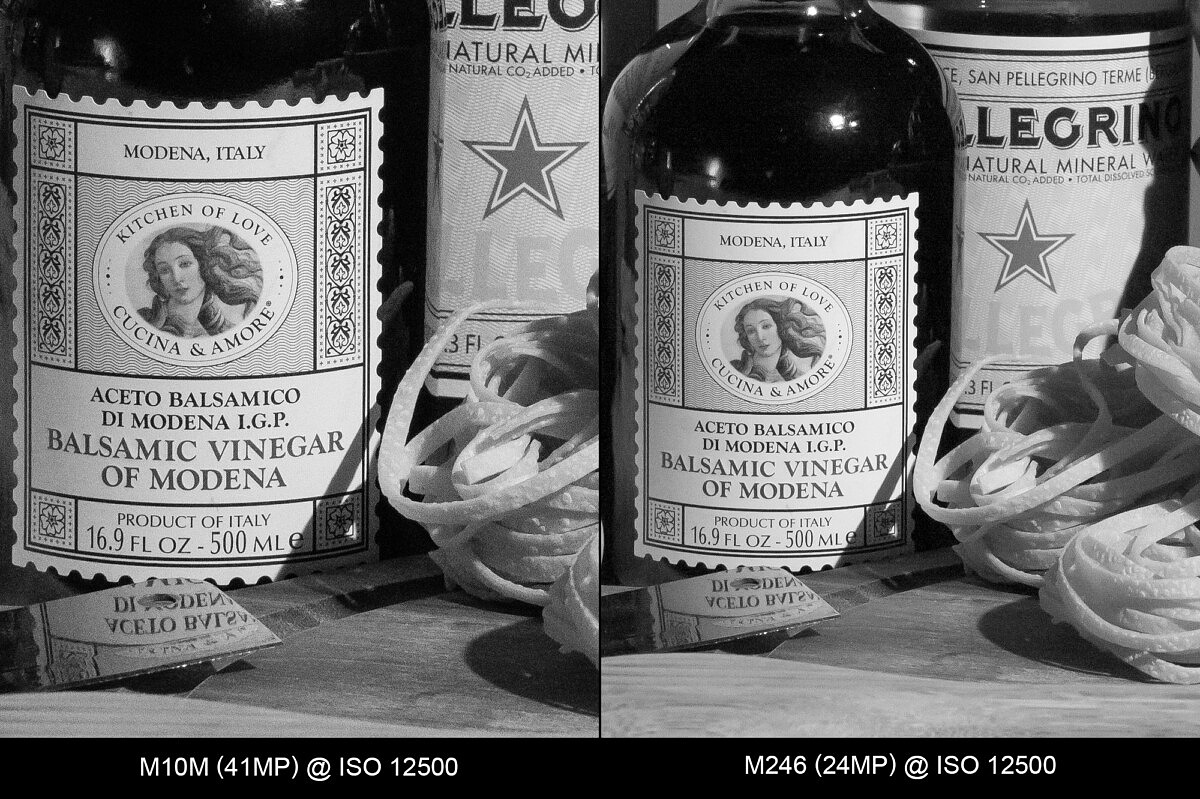
ISO 16000 vs. 12500

ISO 20000 vs. 12500

ISO 25000
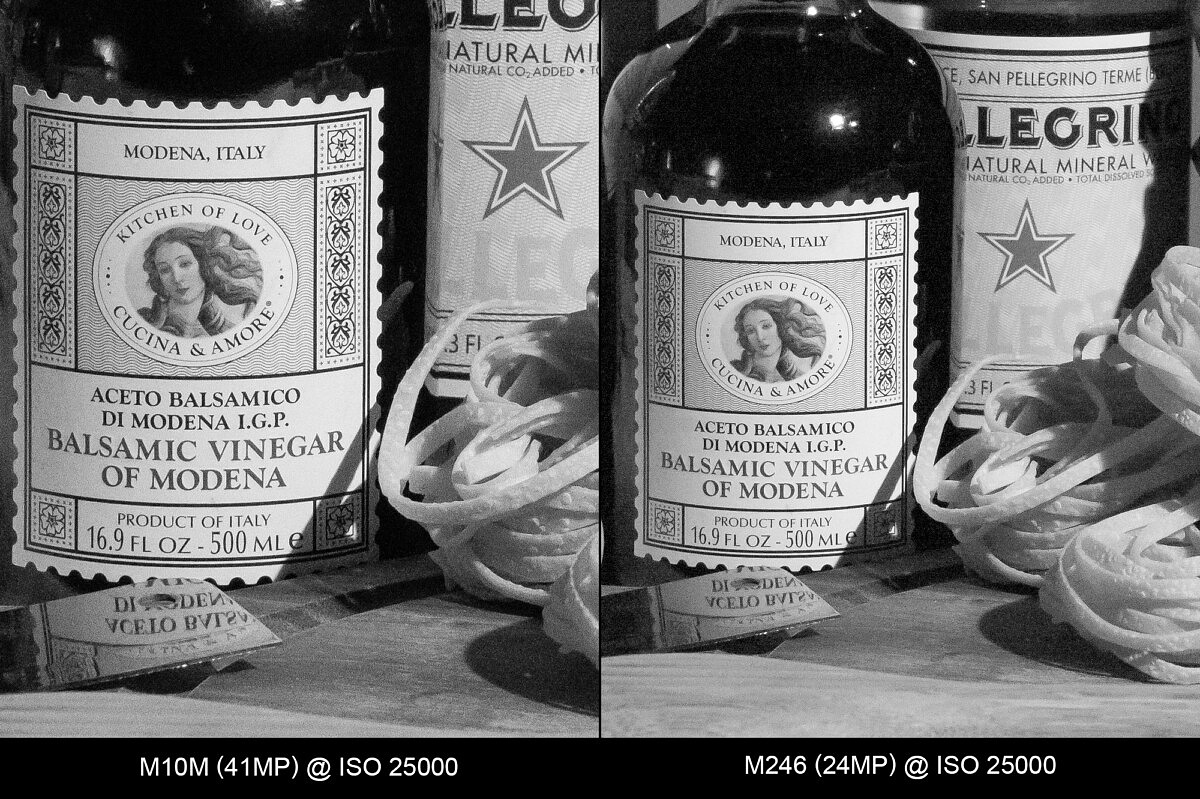
ISO 32000 vs 25000

ISO 40000 vs. 25000
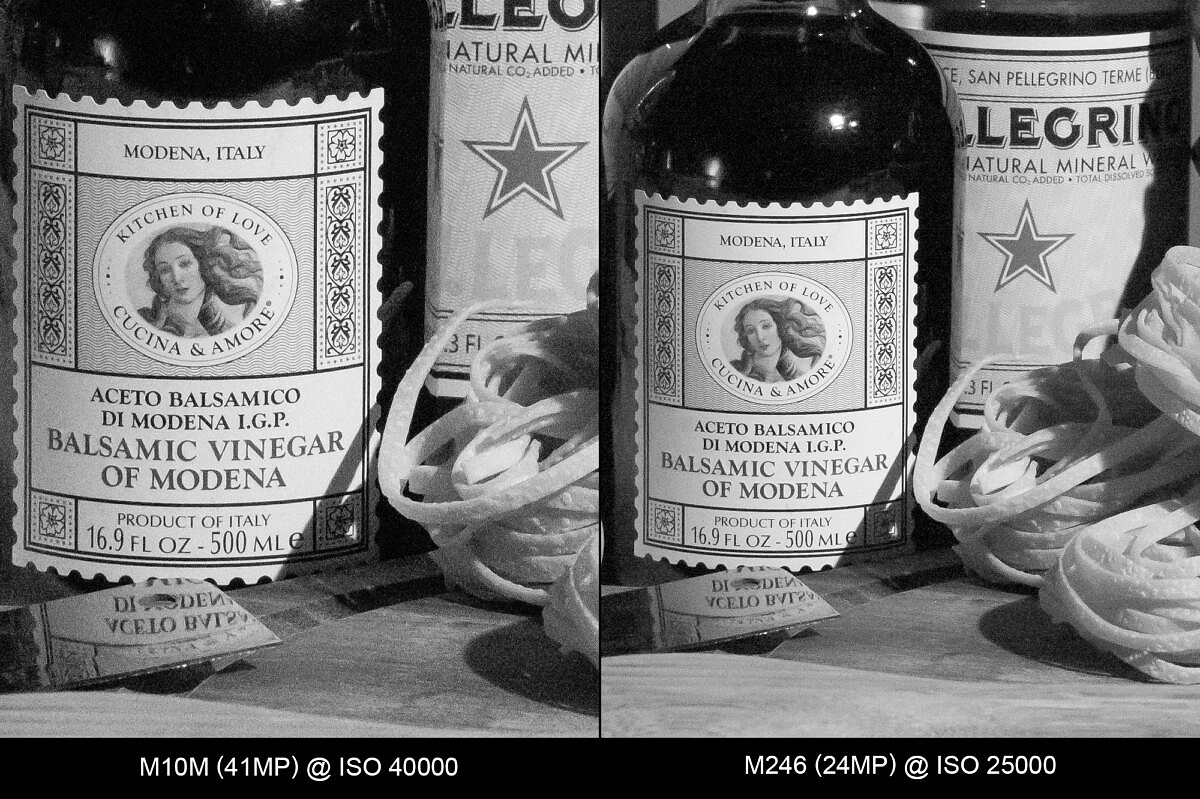
ISO 50000 vs. 25000

ISO 64000 vs. 25000
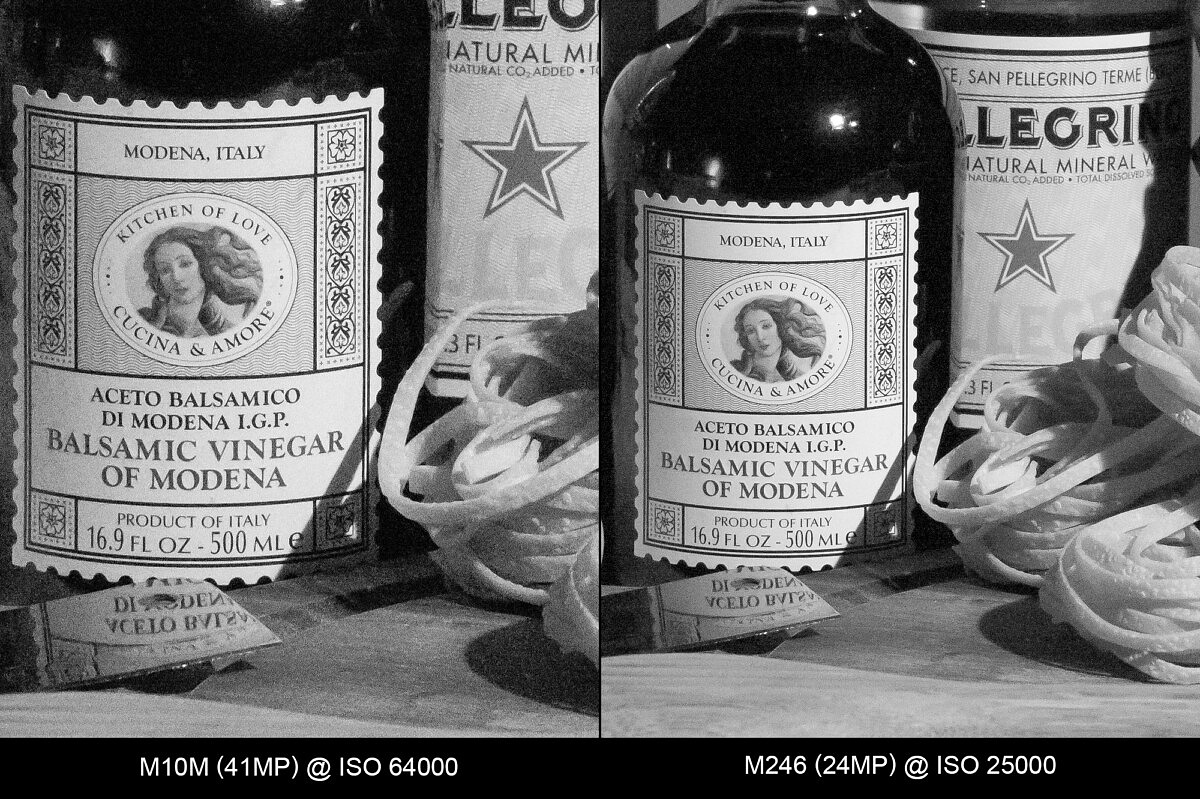
ISO 80000 vs. 25000

ISO 100000 vs. 25000

Native Resolution Comparison: M10M vs SL2

For our final comparison, I've matched up the 47 megapixel SL2 with the 41 megapixel M10 Monochrom. Both are displayed at their native resolution at 100%. As I outlined in the introduction, the SL2 images were converted to black and white using Lightroom's default Adobe Monochrome profile, with minimal Basic Tone edits and small tweaks in the Black & White Mix palette to better approximate the tonal response of the M10M.
What surprises me the most here is just how much of an obvious resolution jump we see just with six additional megapixels. I would have figured the real-world difference to be less noticeable.
ISO 200
Both the M10 Monochrom and the SL2 offer up incredible resolution and textural detail at low ISO. For pure detail the SL2 has the edge here as we would expect given the pixel advantage.


ISO 400
As expected, not much changes at ISO 400. Interestingly, the M10M is completely noise-free, while the SL2 shows very tightly patterned noise. This takes away nothing from the image, and I suppose I could have used more aggressive noise reduction for the SL2, but shows the advantage of no per-channel gain for the M10 Monochrom.


ISO 800
At ISO 800, we see very similar results to ISO 400. Both cameras continue to produce largely noise-free images with outstanding detail.


ISO 1600
At ISO 1600, the M10M continues to be perfect. The SL2 is starting to lose just a bit of fine detail. Also, of note is that the SL2 exposure seems to be getting darker and less contrasty. This trend will continue as the ISO increases. My guess is that the dynamic range is starting to suffer and this is the visible result. If I had chosen to adjust tone settings on a per-image basis rather than per-camera, some of this could have been compensated for.

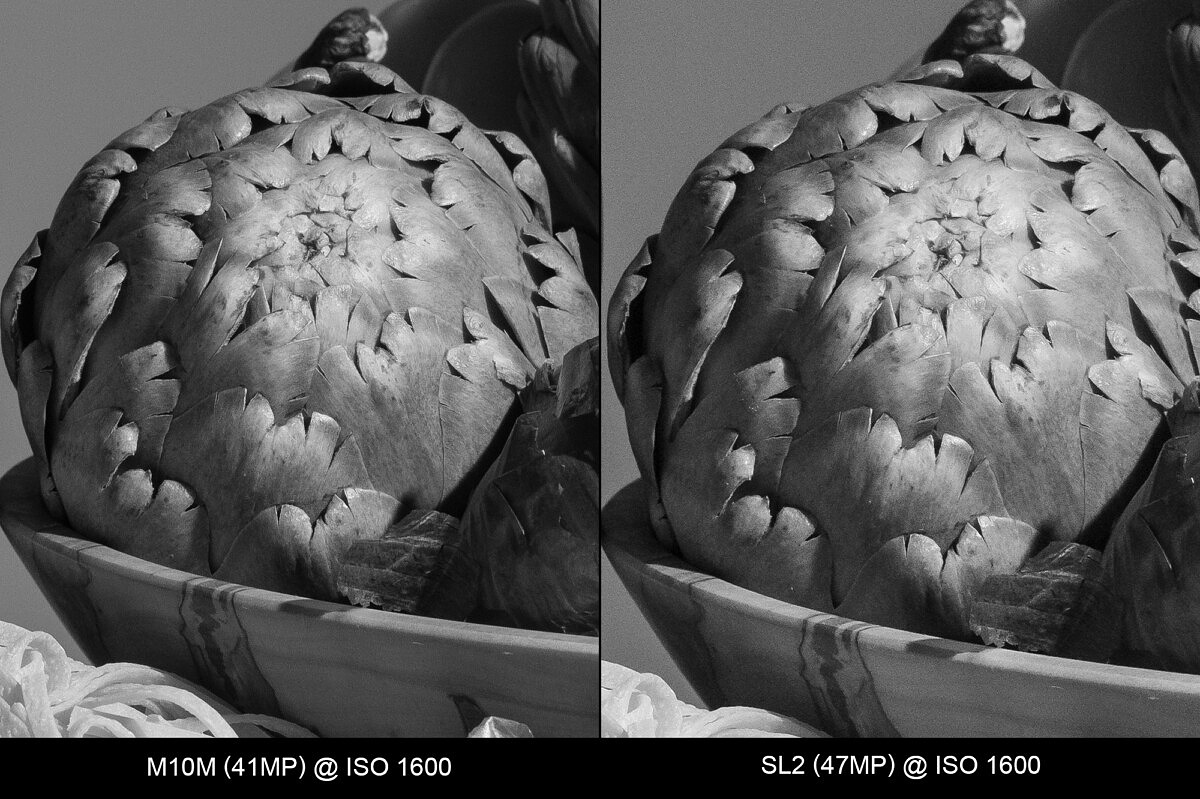
ISO 3200
Performance at ISO 3200 is very similar to ISO 1600. Both cameras look excellent.

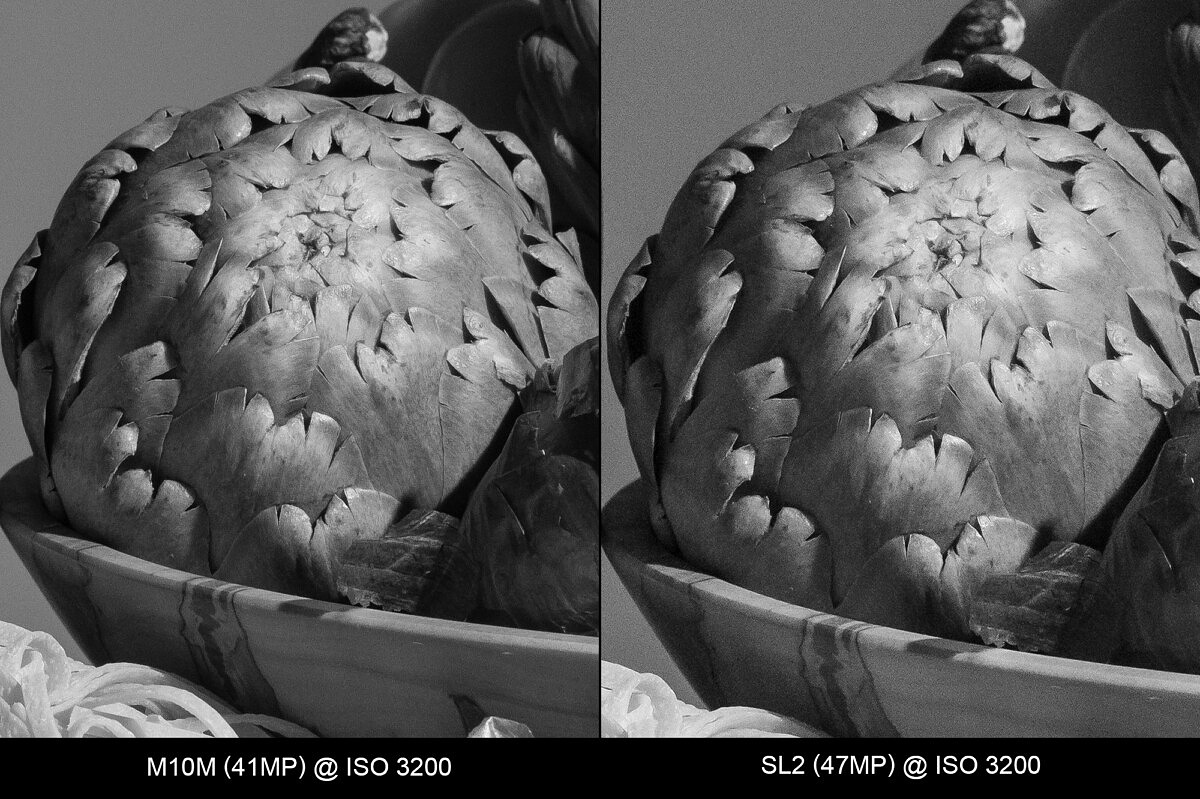
ISO 6400
While the M10M continues trucking along at ISO 6400, the SL2 is starting to show a slight decrease in overall image quality. A bit more noise, a little less detail and a small drop in dynamic range all contribute here. ISO 6400 is still completely usable on the SL2, just not as good as staying below ISO 3200.

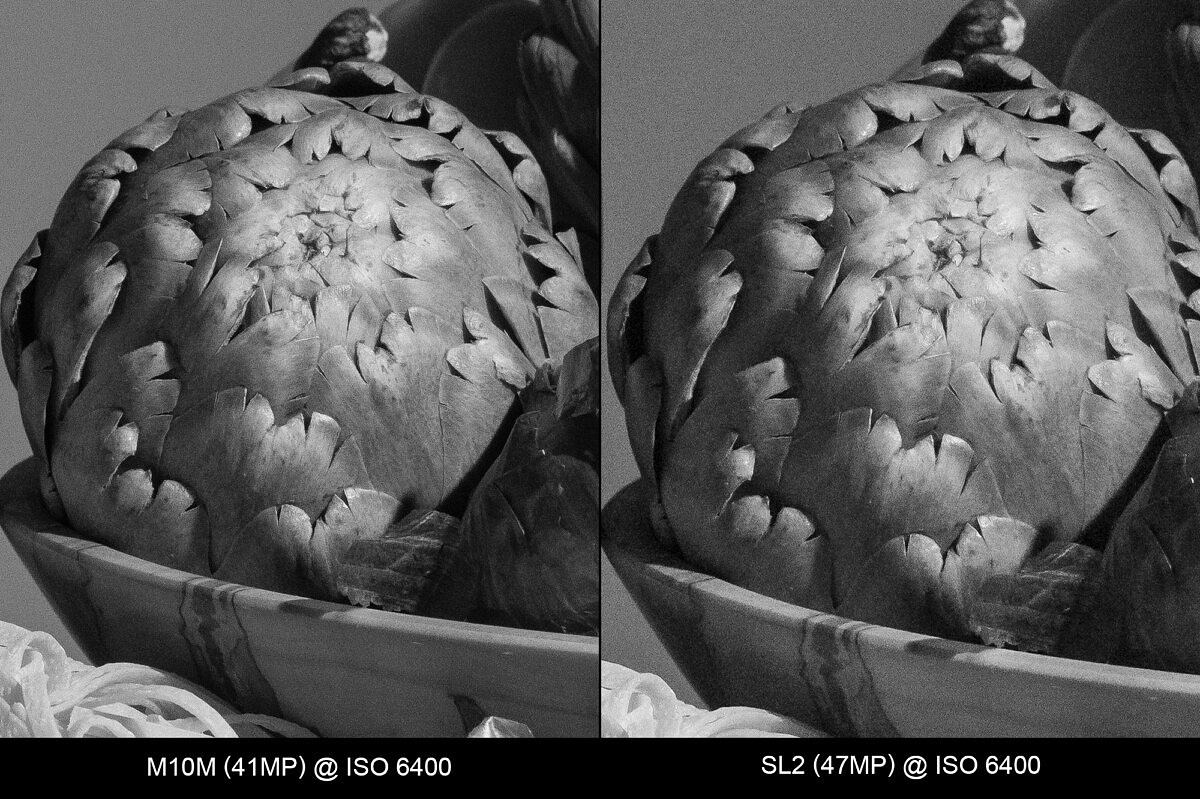
ISO 8000 vs. 6400
Because the SL2 only has whole ISO steps, we're going to lock it in at ISO 6400 while ticking up another third for theM10M. And no surprise here. The M10M looks better at ISO 8000 than the SL2 does at ISO 6400.
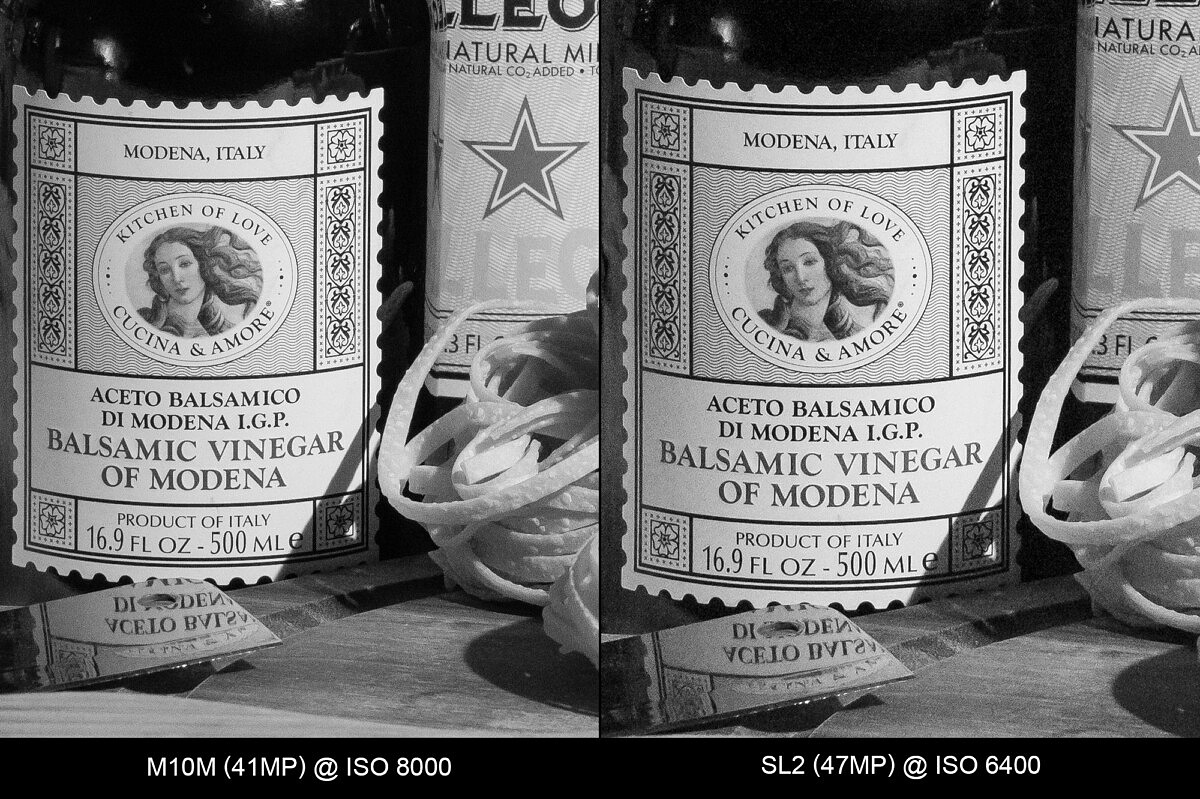

ISO 10000 vs. 6400
At ISO 10000 the M10M is producing equivalent image quality to the SL2 at ISO 6400. And as we'll see after jumping to ISO 12500, this will be the best case for the SL2.


ISO 12500
Now, with the SL2 bumped up to ISO 12500, the M10M pulls ahead significantly. The M10M still looks roughly the same as ISO 10000, but the SL2 is showing noticeable degradation.


ISO 16000 vs. 12500
At ISO 16000 and 20000, the M10M is much better than the SL2 at ISO 12500.

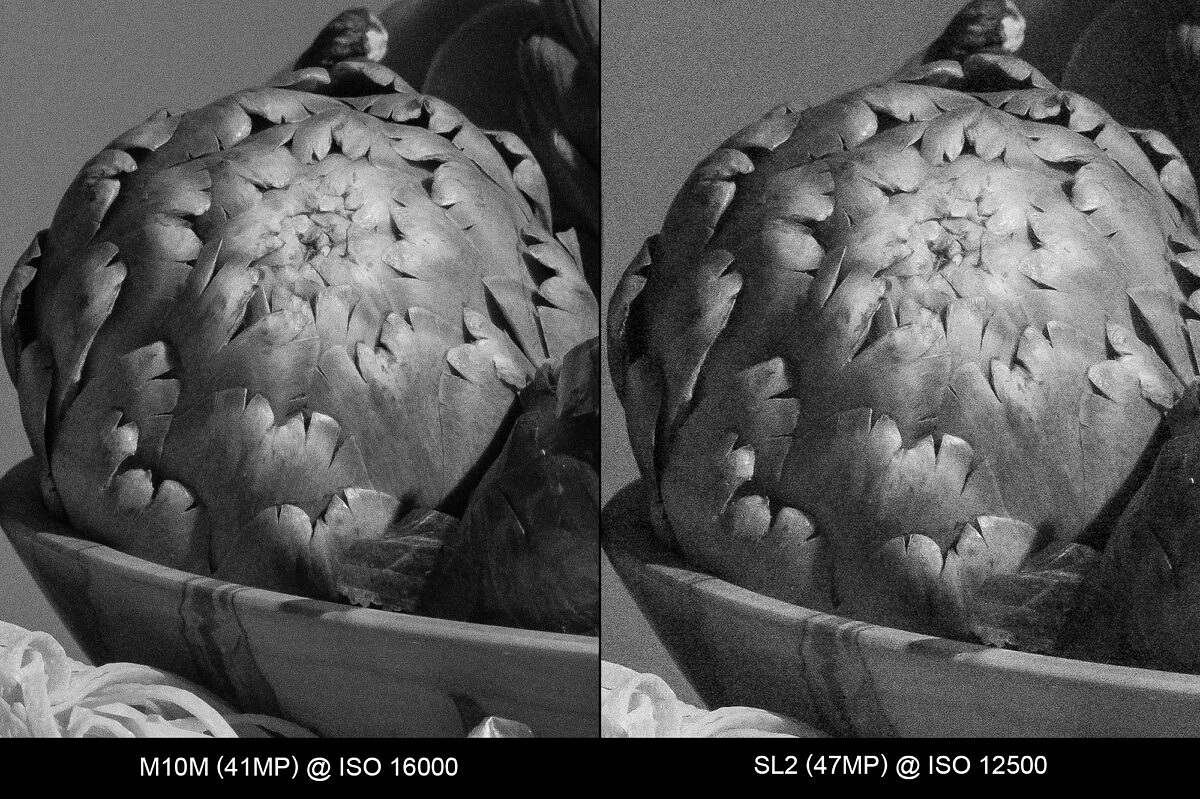
ISO 20000 vs. 12500
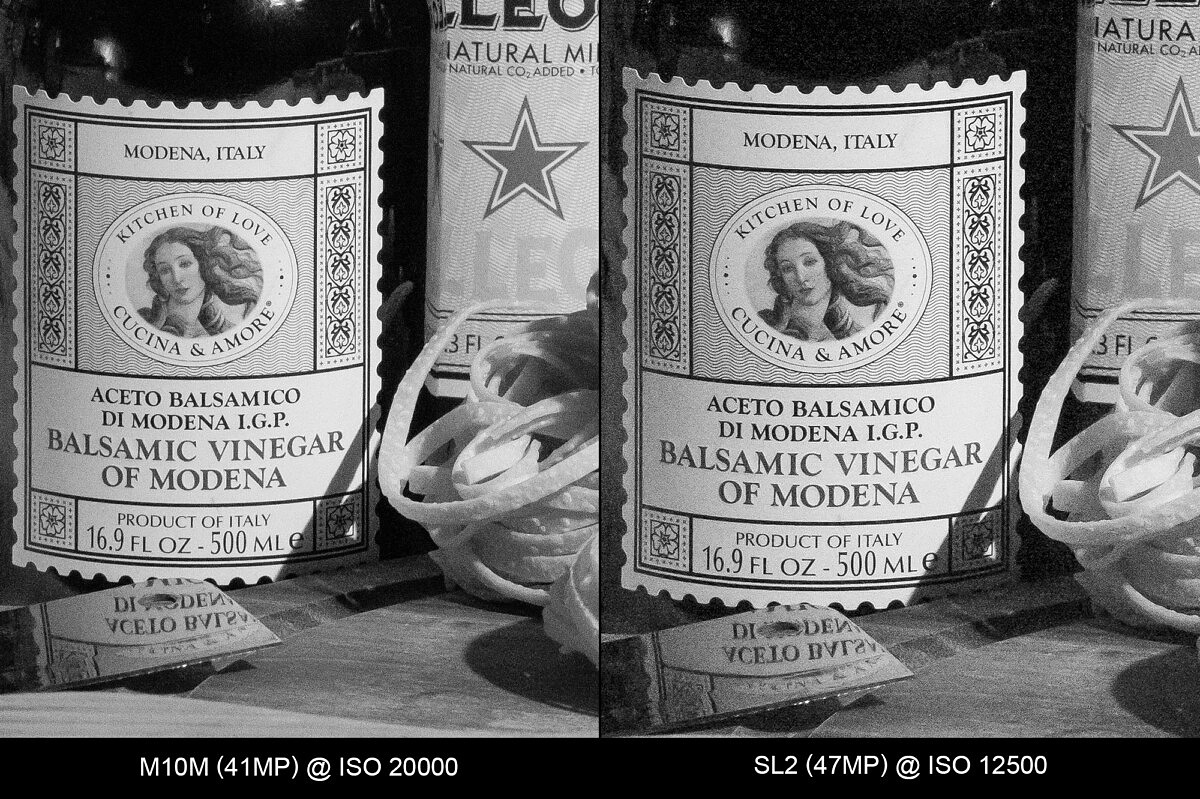

ISO 25000
At one stop from its maximum ISO setting, the SL2 is no match for the M10M. The quality difference observed at ISO 12500 – 20000 is even more pronounced here. While I'd consider the results at 25000 to be borderline usable on the SL2, the M10M still looks great.
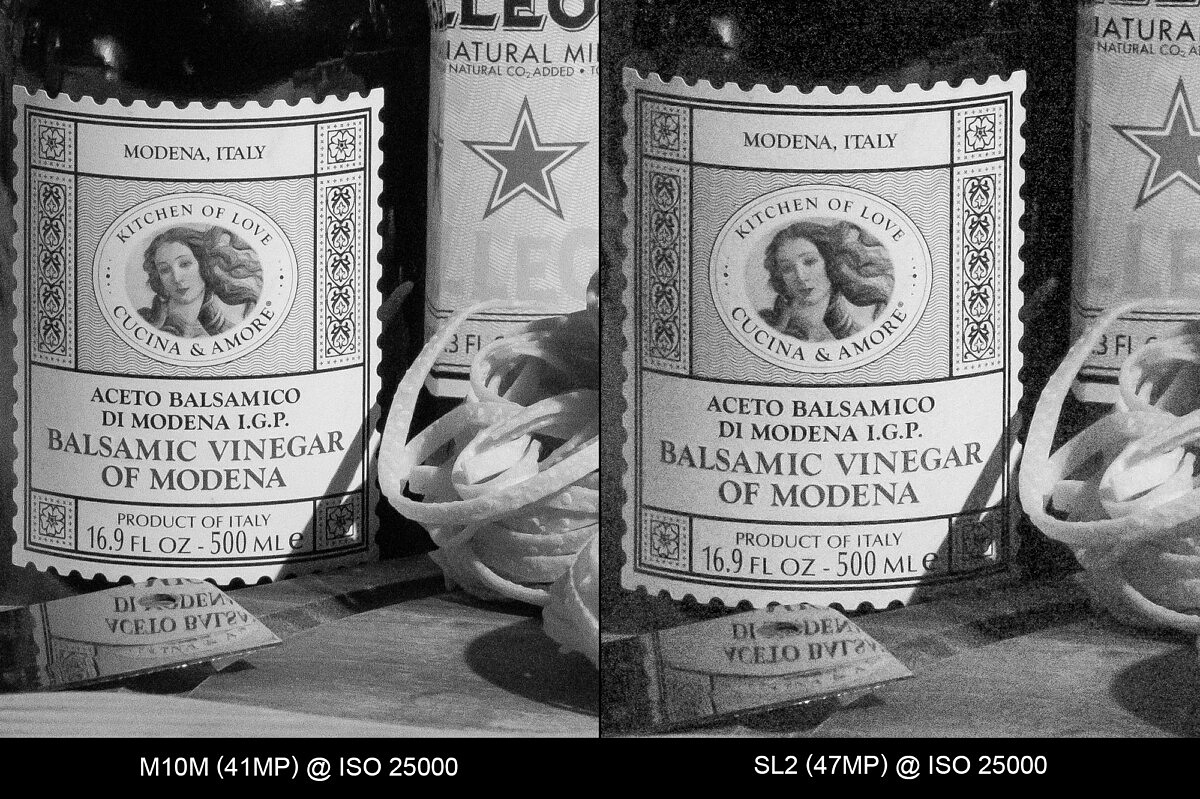

ISO 32000 vs. 25000


ISO 40000 vs. 25000
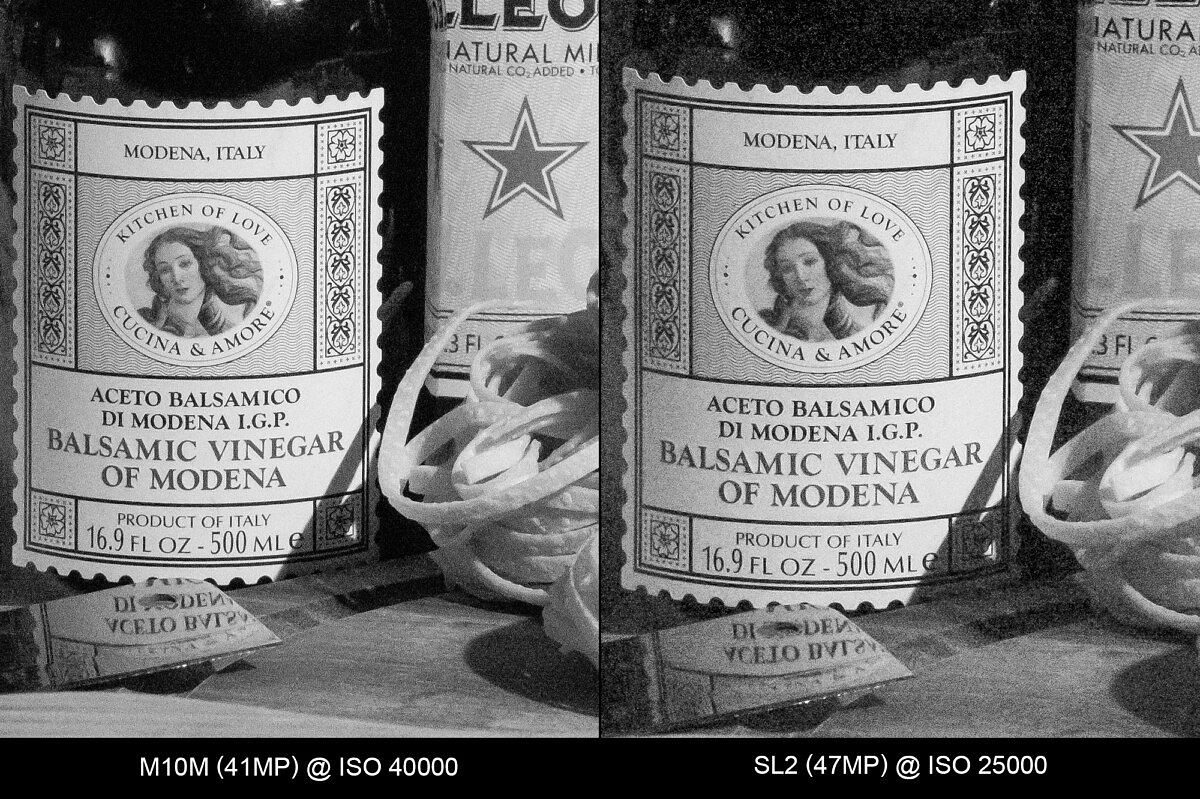

ISO 50000
Now at the upper limit of the the SL2, results at ISO 50,000 are fairly unusable. There is an overwhelming amount of noise, even with aggressive noise reduction. Detail is sacrificed both due to noise, noise reduction and lack of dynamic range. Meanwhile, the M10M continues to put up a decent image.


ISO 64000 vs. 50000
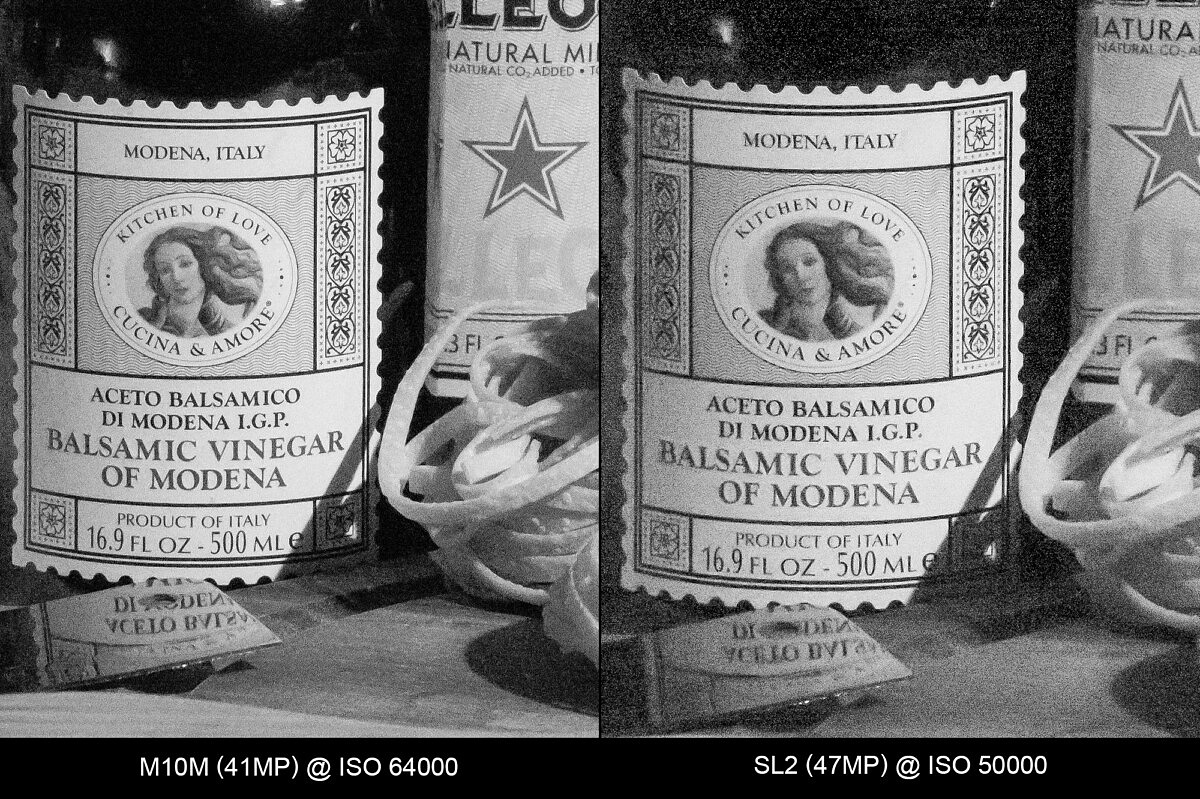

ISO 80000 vs. 50000
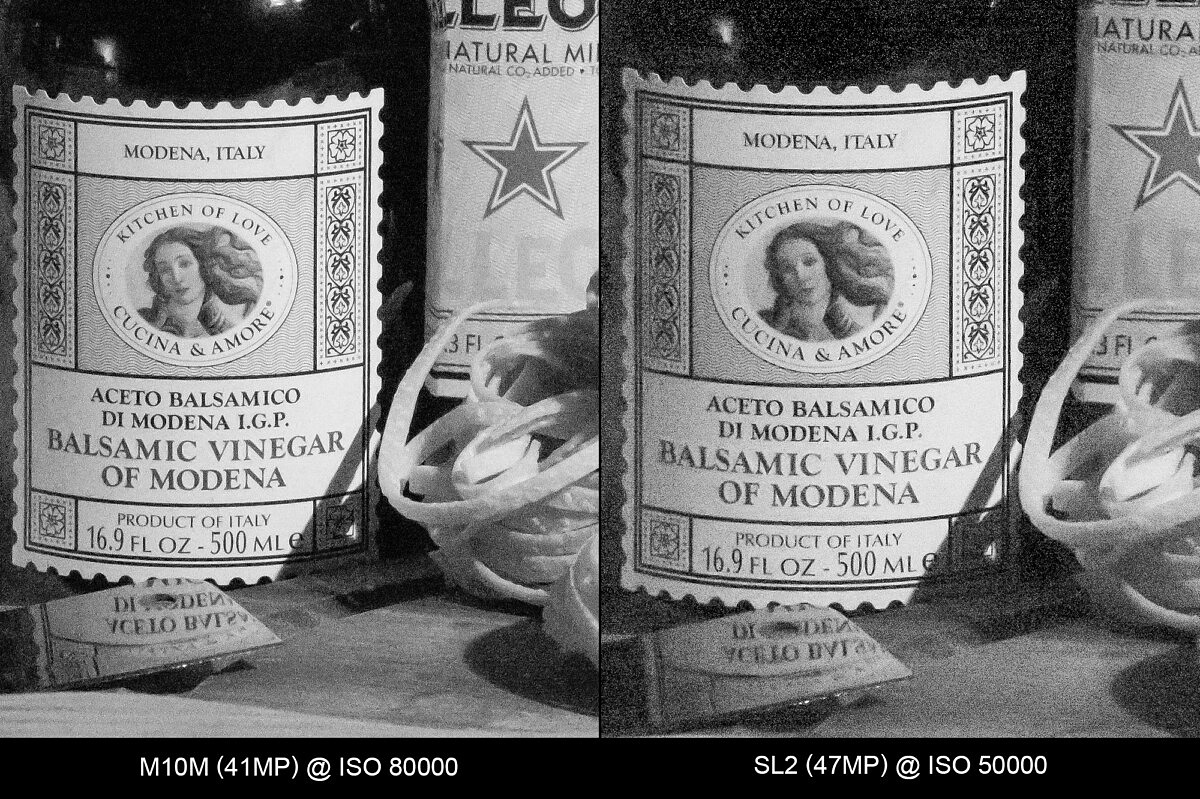

ISO 100000 vs. 50000
Even when maxed out at ISO 100000, the M10M still produces a better image than the SL2 does at ISO 50000.
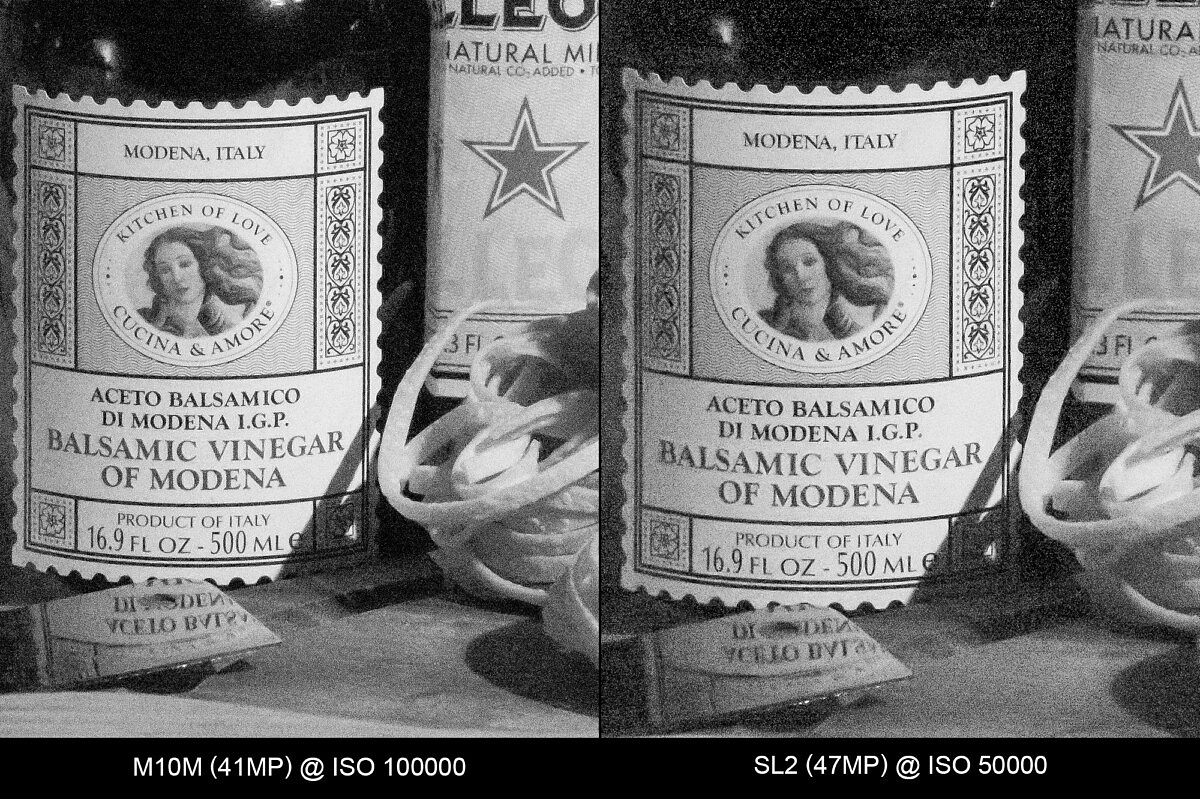

Best of High ISO Settings
For this last comparison, I've put what I consider the highest ISO setting from each camera that represents the best balance of light sensitivity, detail resolution and acceptable noise. For the M10M, as in the roundup of M cameras, ISO 32000 looks phenomenal and gives up very little regarding image quality. In order to visually match up to the M10M, the SL2 puts up a decent, if not super-impressive ISO 6400. With discrete 1/3 stop increments, we probably could have gotten more, but ISO 12500 was simply too much sacrifice for my tastes. The net result is a 2.3 stop advantage for the M10M over the color flagship.

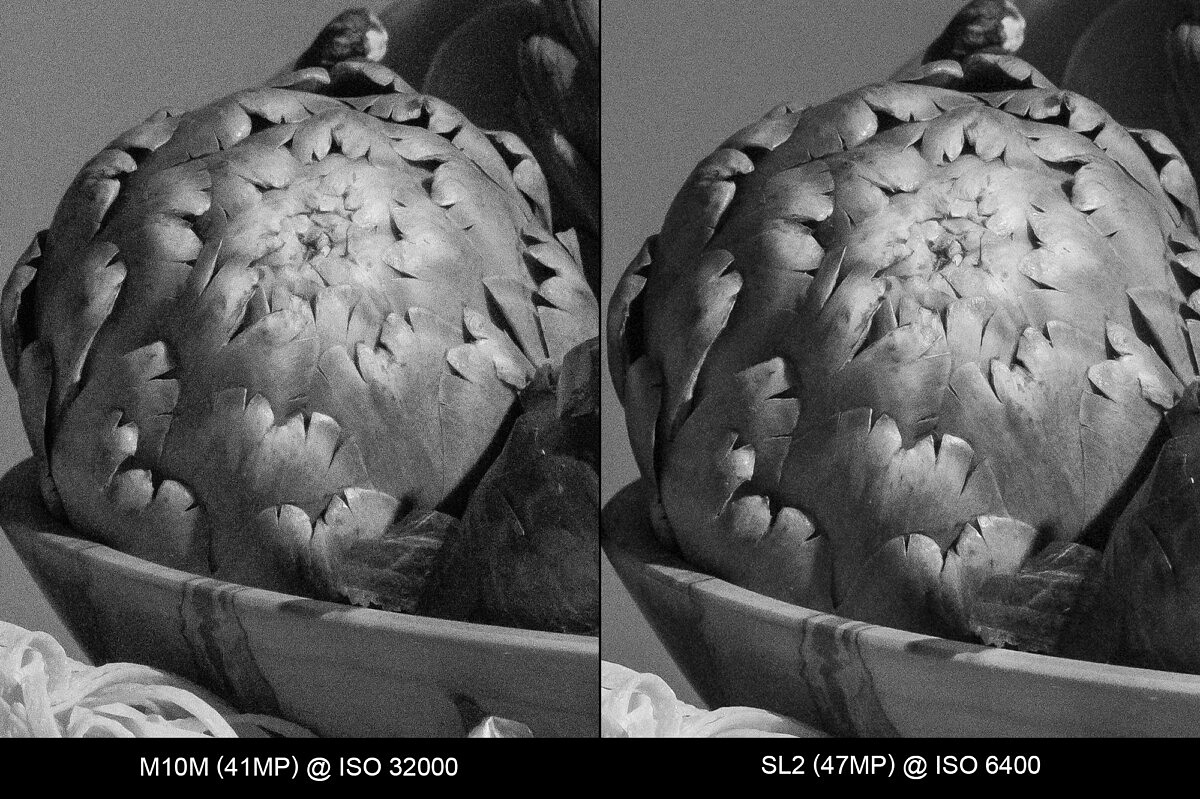
Final Thoughts
My number one takeaway: The M10 Monochrom is absolutely incredible in its ability to balance detail resolution with noise suppression, offering low light capability unimaginable just a few years ago. With that out of the way, let's take a quick look at how the M10 Monochrom matches up against the M contenders and the SL2.
Tackling the M lineup first, the M246 at five years old, puts up an admirable fight against the much newer M10-P and M10 Monochom. And if all you need is solid ISO 12500, the M246 still represents an amazing value in 2020. The M10-P, for its part, did even better than I imagined. Sure, really clean results top out around ISO 10000, but the camera can push past there in a pinch. As noise increases, sharpness and detail are largely maintained. Ultimately, the M10M posts around a 1.5 stop advantage over both the M Monochrom (Typ 246) and the M10-P at their best case settings, but can extend that lead to over 2 stops as ISO continues to increase.

The results from the SL2 were somewhat unexpected. As the current technology flagship for Leica, I was hoping for a little better showing from the SL2. With an optimal top end of ISO 6400, the SL2 can still claim the resolution and detail crown at the low-to-mid range of ISO values, but suffers from noise and reduced dynamic range at ISO 12500 and above. The net result is a 2.5 stop improvement in high ISO of the M10M over the SL2.
That being said, having used the SL2 extensively for the last several months, I never felt limited by its ISO range. And because of the effective sensor-based image stabilization, I rarely need to go past ISO 6400. Given that it offers double the resolution the of the M10, I'm willing to make that tradeoff in order to maximize image quality for my landscape photography and gain access to the exceptional SL lenses.
The M10 Monochrom, on the other hand, has allowed me to shoot at 1/500th of a second, under almost any lighting condition, taking a completely different approach to eliminating camera shake. With the M10 Monochrom, you simply don't need to ever worry about ISO.
Hopefully, you found the results here helpful in understanding the black and white capabilities of all these excellent photographic tools. Ultimately, any of them will work extremely well for real-world photography. Whether you prioritize the unparalleled low light prowess of the M10 Monochrom, the value of the M Monochrom (Typ 246), the flexibility of a color M with the M10-P, or the technically advanced feature set and ultimate resolution of the SL2, will be up to you as a photographer and what works best for your photography.

Thanks for this well thought comparison test.
It will definitely help anyone understand the differences among these great cameras when it comes to high ISO/B&W, and hopefully ease the decision making process on which camera to use.
Thanks again,
E.C.
WOW, Thank you! I own Both the M10m and the SL2, I just got my SL2 last week. I love the way it handles, it’s simplicity, its look and feel, its EVF. But I did notice a lot of noise, and how easily it is to blow the highlights. And now this. Such a surprising poor performance by the SL2, wow, truly not a great showing. 6400 ISO max, that is really low and really limits its usability.
While ISO 6400 is the optimal balance of sensitivity and noise on the SL2, I feel that ISO 12500 is also perfectly usable when necessary. Remember, the SL2 still offers more detail resolution and access to native SL glass, which are superior to M lenses across the board. Even the incredible 50mm APO-Summicron-M I used for this test was outresolved by the 50mm APO-Summicron-SL. I didn’t included these results as I didn’t want to introduce even more variables into the mix. The in-body image stabilization on the SL2 is a revelation and has negated much of the need to venture into the super high ISO settings anyway, at least in my shooting with the camera over the last several months. The SL2 as a platform overall makes it a far better tool for my landscape photography. Weather sealing, ruggedness, optics choices, OLED EVF, 4K60 pro-level video, IBIS, etc. And ultimately, even with twice the number of pixels, the SL2 is only slightly behind the M10-P in this test.
While the SL2 may look a little out of its league next to the M10 Monochrom, I think that has more to do with the M10M being so far superior in low light capability than any of the other very capable cameras in this roundup. Your setup of the SL2 and the M10M is really the best of both worlds. Extreme detail and flexible performance in color with the SL2. Ultimate low light champ in B&W with the M10M. As my colleague Josh said in one of our recent livestreams, we are truly spoiled for choice.
As far as blowing highlights, our suggestion on all modern digital cameras is to expose for the highlights and pull up the shadows in post. You will always get a better result this way. The old days of ETTR (expose to the right) are simply not valid anymore with cameras that offer 14-15 stops of dynamic range and excellent SNR.
Thank you David, I do think I have the best of both world. Now if only I could get out of my house and shoot!!!
Why are many of your M10M images labelled 24 mega pixels?
I explained this in the methodology section on resolution. Basically, in order to show the most apples-to-apples comparison between the three M cameras for a given output size, I downrezzed the M10M from 41 to 24MP. For the direct two-way match-up against the M246, I did use the native 41MP. This allows an for an evaluation both output-limited and at absolute resolution.
Doubtful decision. That would only make sense to a user if the M10M user were to decide to crop everything down to 24 megapixels. And why would anyone ever do this. You over thought your experiment.
Appreciate your work, however.
John, it is you who are over analyzing and not getting the point here and what it takes to write an article for those with multiple viewpoints and needs.
A question: When shooting at high ISO, how much more shadow detail is recoverable from the raw files in the M10P versus the M10M? Noise isn’t everything. I often find the noise on my M10P quite attractive in low-light shots, but more shadow detail is always desirable.
While I didn’t test specifically for this and applied the same basic tone to all images, I would imagine that the M10 Monochrom will provide for more shadow recovery than the other cameras. We can base this on the rate of increase of noise as ISO ramps up. The M10M sees very little degradation over most of its ISO range. That tells me that a fair amount of gain could be applied to the shadows and the equivalent ISO based on gain will still be extremely clean.
You should take the color images into photoshop and throw out the two noisiest channels in the channel mixer which are usually blue and red. Then you will have far fewer artefacts as the green channel is usually a stop better than the blue channel.
Interesting idea. Back in the day, we’d use LAB space and drop the AB chrominance channels, while keeping the L luminance channel. For this test, my goal was to show “normal” processing in Lightroom. Also, if you drop the red and blue channels, you wouldn’t be able to use the Black and White Mix (channel mixer) to fine tune color-tone mapping.
Indeed. The LAB method is quite similar, I haven’t compared which works best.
You can’t use the Black and White mix with the Monochrom camera anyway so its kind of even 😉
David, that was a lot of time and images! It appears in general, what I was suggesting when the M10M came out (and I began to use it early on) is holding true. The other aspect here is that the M246 and M10 have essentially the same sized pixels (or light gathering power) and the M10M has a smaller pixel size (I believe it has decreased from 6microns to 4microns). So, the M10M is already at a light gathering disadvantage compared to other two models – but it isn’t visible. The read noise of the M10M is low enough that this is one case where size does’t matter. Even more advantageous, is that for large prints (for me that is 17×22) I don’t need all the pixels, so the noise can be reduced through standard printing of images. So in summary, you have eloquently shown that with lower light gathering power in the pixels, the M10M is at least essentially equal to the M246 in lower ISO’s, but with much higher resolution in the image file, and potentially more shadow information that can be extracted. Equal on the surface, but much more underneath. Thanks for summarizing all your work! A pleasure to read. DMK.
Great points, David!
David,
This was great and very informative. You definitely outdid yourself on this one. This helped with some questions I had about M10M and SL2.
Mark
Thank you – this is interesting. An an owner of the SL2, M10 and Q2, the main reason I might be interested in the M10M is the high iso performance in low light, which is very impressive. However, I had also thought the M10M might provide tonal gradations and an overall look that would distinguish itself from the other cameras. From this test I don’t see that, but perhaps it’s there in other contexts – I would be interested in getting your viewpoint on this, especially since you give up playing with color channels by using the M10M.
Excellent review David. I use the M9M and never saw a reason to upgrade for monochrome to the MM (M246) but with this I can definitely see a reason to go M10M. My next M camera for sure, once I can again venture safely in the streets. Thanks for the details and hard work to put this together. Much appreciated. Cheers ?
Hi David,
after watching your excellent Camera Talk on May 9th which I truly enjoyed (!), since then I caught myself checking your website daily to read upon your then-announced review that you finally published today. I think you did a great job in designing all your experiments to ensure that you indeed compare apples-to-apples. And I also agree with your approach for simplification. However, I feel that it is not entirely correct to compare images taken with the combination of SL2 & M lens versus M cameras & M lens, latter particularly designed for each other. I realize it may be a big ask but I am wondering if you could post and compare images taken with the SL2 & SL 50 mm lens vs M cameras & M lens, and do this at least for ISO6400 and ISO12500 at say 40 MP for both the M10M and the SL2, and keep everything else constant? Am I correct to hypothesize/assume that these SL2-based images taken with the SL lens depict less noise for both ISO values (certainly for ISO12500) than taken with the M lens?
Best, Armin
Thanks for the feedback.
Just for fun, I did shoot a sequence with the SL2 and 50mm APO-Summicron-SL which testing. Ultimately, I didn’t feel it fair to include for a couple reasons. First, the effective focal length of the M and SL lenses aren’t the same. And second, the SL lens was visibly sharper. Yes, than the 50 APO-M. Using the same lens for all cameras, from the same distance, allowed me to isolate the independent variables – namely the individual cameras/sensors.
To your answer your question though, no, the lens wouldn’t have an impact on noise at a given ISO setting. This is sensor dependent. Sure, the SL lens would result in slightly more detail resolution, but that wasn’t the ultimate test here.
I appreciate the detailed descriptions of the testing methods as well as the logic behind them. An understanding of the test methodology is incredibly important when interpreting results. Yes, the M246 results are simply remarkable.
One thing that I particularly like about the Monochrom cameras is the noise structure that creeps in at the highest ISOs. I think Leica recognizes the fact that many Monochrom users add grain to their images to give them a more “classic” look and feel. It would be very interesting if Leica explored this a bit more and developed grain profiles modeled after classic films (400TX, P3200, etc) tailored specifically for Monochrom images shot at low ISOs. A corresponding drop down box in Lightroom would allow you to select the grain profile that you desire.
Anyways, it’s a dream. Perhaps I should develop some presets for this very purpose. I wonder if anybody would be interested in using them.
Have you tried out SilverFX? You can select different classic film types and it applies a look, including grain profile.
Thanks David, very good read. I have been drooling over the M10M but, if anything, this convinces me to stay with my M10 and spend the extra on lenses – perhaps even the 50 APO – or maybe a Q2 for that bit of extra resolution.
Glad you found it useful. The M10 put up a really impressive performance here. If you don’t want the extra resolution, or need to shoot over ISO 10000, the M10 is certainly capable even in B&W. Lenses are never a bad investment, affording you added visual flexibility in your toolbox. And the Q2 is just fun, providing that extra resolution if needed, along with the ease of autofocus.
Hi David. A very well executed test that highlights the strengths and weaknesses of each sensor. Well done and thank you for your report. I’m tossing up between getting the M10 Monochrom or the SL2. As you have shown, the high ISO performance of the M10 Monochrom is like having an “M” with IBIS. I place micro contrast higher as a priority than resolution. Resolution is often only seen if you pixel peep where micro contrast, you also see when viewing the image from afar, particularly when viewing a big print. Your images clearly show a loss of micro contrast in the SL2 as ISO is raised, relative to that of the Monochrom (especially in the artichoke crops). The micro contrast of the M10 Monochrom is impressive even at high ISO’s. The resulting “PoP” that I see in the bowl of vegetables, (i.e. Jpeg Monochrom image at ISO 160), is amazing and when printed big will “Wow”. This is truly low ISO film 4×5 stuff. “Leica, Take My Money”. I will leave it to you to guess which camera I’m getting. You really have crystallised my purchase decision. David, thank you once again.
Good observations and summary!
Thank you for your test.
Let us say I mostly shoot day street and interiors; usually, my top ISO is around 3200/6400. What is the advantage, besides better high ISO performance, of using a Black and white only sensor like the M10M?
I am more interested in tonality, detail, gray gradation than ISO performance and I am not sure that a monochrome sensor is going to make any difference when using low ISO.
Thank you
You’re still getting better quality at ISO 3200 and 6400 with the Monochrom. And less noise does result in smoother, more detailed tonal gradations. Download the full image sequences and look at the gradient background. Also, I had to work to get the color images to match the Monochrom ones, and still couldn’t get 100% there.
Thanks for this test.
But it don’t show différences about banding.
I have banding in shadows with my M246 from ISO6400, 10.000ISO are unusable in concert photography because this.
What’s about banding with M10P, M10M and SL2 ?
I wasn’t really testing for banding, as this is often a function of pushing the shadows. Very often banding can be mitigated by pulling the blacks down.
I’d encourage you to download the full images and take a look in the shadow areas of the dark background.
I guess I’ll hold up to my M246. That beautiful beast!
This is a vast amount of work and it is very
Specific! Congratulations
However , I would like to see this comparison
Done with Fox’s U Bet Chocolate Syrup!
Larry
Haha. Next time I’ll try to shoot something other than Italian food.
David, thank you a very detail analysis of the ISO performance of the cameras. I’m sure many others will find it helpful, as well. Similar to Peter’s question above, I would be interested in your assessment of B&W tonal graduations, or color translation (rendering) differences between the M10M and SL2 (e.g., more possible shades of gray with the M10M? etc.).
In theory, the M10M should provide superior tonal transitions, but I will leave it to the viewer to determine by how much. Of course, with so much better noise suppression, you will already get smoother tonality and gradation at any given ISO. At base ISO, this isn’t as visible. Please download the full files and take a look at the gradient background at different settings. This and other areas of the test image will certain demonstrate this advantage.
That’s a TON of work, David. Thanks for the information.
Indeed it was. But worth it.
Thanks for the comparison… will hold onto m246 for now…helps a lot in decision making… also is there any comparison with q2, being 47mp sensor.
The M246 is still awesome in 2020. No doubt.
I’d point you to the SL2 comparisons. The SL2 and Q2 share a very similar sensor architecture and the same resolution. I think you’ll find they respond quite similarly.
Very comprehensive test suite. Thanks for providing this. After considering all this I’m left with the same feeling I’ve had all along about converting color images to b&w… it’s OK to do this when you have no other options. However if you truly want to shoot b&w (or in the case of Leica’s Monochrom cameras in gray scale) then buy the appropriate tool and have at it. When you buy the best you only cry once.
David, Thanks for your dedication and hard work in doing such tests. As an owner of both the M10 Monochrom and the SL2, I really appreciate it.
My pleasure.
Hi David. This is an excellent test article with exhaustive detail. I current use the M10, M10M and SL2.
It is very enlightening with regard to the high ISO capabilities of each of the cameras. Since I usually do not use above 6400 for most of my applications, I find you comparisons very helpful. I must admit that I will be more inclined to use the M10M more freely at the higher ISO’s.
Thanks for providing a great study.
Best, Jim B
Jim,
Don’t be shy of venturing up into the higher ISOs of the M10 Monochrom. As someone who rarely shot anything faster than ISO 200 in my film days, it took me quite a while to get comfortable with the idea of a totally usable ISO 32000. But now I can’t go back. 🙂
Thank you very much for this very interesting test. I work very often in Egypt and Sudan and I own a M10-P and a M10-M… and I used for many years a M240 and a M246. (I also used two Nikon 700 and 810, so I can compare.)
For me the two new M10 are much better than the one they replace (dynamic range, exposure, high ISOs…). I had the opportunity to know what we can get in real conditions and I decided to limit high ISO range of the M10-P to 6.400 and that of the M10-M to 25.000… with the possibility to go to 50.000 if needed. Thanks to your test—that I hat no time to do for myself, thank you very much—I now have an objective validation of my field experience.
Speaking of the Apo-Summicron 50, it’s an incredible lens and with it we really have the impression to draw pictures with the light almost as if there was no glass inside.
I was planning to buy a SL2 for macrophotos (objects pictures) and videos and, thanks to your very interesting article, I think I’ll get it for the next mission.
Best regards form Paris,
Olivier
Hi David. Very interesting, thanks. I might have missed it in my first read-through, but did you test in actual low light? In my experience, the different sensors react differently when the actual incoming signal is very low, ie in the dark, rather than testing high ISOs in ‘good’ light.
While I didn’t test in the dark, I did need to make sure that the single light source was low enough to get a proper exposure at ISO 100000, but not so dark that I ended up needing dark frame subtraction (LENR) at base ISO of 50 on the SL2. Quite the exposure puzzle. And as I pointed out in the article, I did use a studio LED light with a CRI of 97+. I think that perhaps the difference of good light vs. bad light might have more to do with the favorable CRI more so than a higher lux value. So, yeah, I used good light. On a tripod. With self timer. Shooting a 50 APO-Cron ASPH at f/8. These all add up to ideal conditions.
Thank you for the test and for all of the great videos from Red Dot Forum.
I’m trying to decide between the M10P, the M10M, and the SL2, and so this is very timely for me.
Perfect. So glad it was helpful. If you need help deciding, let us know.
David, thanks for all of the time that you put into this. The live sessions that you have been doing with Josh are perhaps my favorite thing to watch during quarantine! I have the M10M and SL2 and am considering getting a 75mm lens. Which do you recommend? I was initally thinking either the APO or Summilux v2. Can they resolve properly for the high megapixel sensors? I have the 50mm Noctilux and was not seriously consdering the 75mm Noctilux due primarily to the weight and difficulty for me to focus.
Fora 75mm, I’d either go for the 75 APO-Summicron if you want small size, or for the 57 Noctilux if you want ultimate performance. Personally, I’d stay away from the 75 Summilux. It’s just not in the same league and I don’t think would be ideal for the high megapixel M10M or SL2…. unless you want the vintage lens for its not-so-sharp glowy-ness. If you’re considering the Lux, the Noct really isn’t that much larger or heavier.
I have used the 75 Summilux for years, with the M9, the M246, all the Monocroms and the SL. It is absolutely stunning. In my view it is much more interesting than the new 75 Noctilux.
I have recently been using it with the macro adapter on the SL2, where image stabilization makes it a joy to use. The image created exceeds in interest almost every other macro solution I have tried.
Great Job!
I’m new here.
Just bought my second hand M246 and your review confirmed my choice…
Thank you very much.
Marcello
Hi David
Thank you very much for your very insightful review. Let me commend you for an outstanding report.
I was blown away by your following statement: “The M10 Monochrom, on the other hand, has allowed me to shoot at 1/500th of a second, under almost any lighting condition, taking a completely different approach to eliminating camera shake. With the M10 Monochrom, you simply don’t need to ever worry about ISO.”
I, probably like most digital Leica M user, have always shot using aperture priority by setting my M10-D on auto shutter speed and auto ISO. Rarely have I felt the need to manually change the shutter speed.
This revelation about the M10M meant I can shoot at shutter speed priority by setting my shutter speed at 1/500 second for example and then let the camera figure out ISO automatically provided I have specified a maximum ISO of say 32,000. That’s not usually an approach favoured by Leica M user.
This is very interesting indeed. Thanks again mate!
Sinply great! Thank you very much for this excellent comparison! As 12.500 is enough for my way of usinig the camera, I will stay with the 246 and buy another lens instead of the M10M.
Best Regards
Udo from Heidelberg
If I missed this out of carelessness I apologize, but I am interested in throwing M10 P with monochrome “on” in the menus. Any thoughts on that? As I own it, it would be the “best price” for me!
As you can see from the testing, the M10-P converted to B&W holds up very well here and is indeed a great option. Turning on Monochrom in the menu will just enable a B&W preview during live view and record B&W JPG files if you are shooting JPG or DNG+JPG. But the DNG files are full color. You will need to convert in Lightroom.
I read your article with great interest since I have recently returned to shooting Black and White and I’m relearning what I knew when I was in High School over 50 years ago. I have an older M9 with a 50mm Sumicron that I shoot with in the monochrome mode only and have been very happy with the results inspite of the obvious compromises. I am planning to move into a true Monochrom as soon as it is possible for me. Most likely it will be a 24 MP simply because of my pocketbook limitations and the fact that the older lenses would perform better on this platform vs the 41 MP units.
Also, my other traveling mate to shoot in color I use my Nikon Df and my older Nikkor glass lenses in the manual mode for full control.
If you really want to simplify, I’d suggest just going for an M10 or M10-P. You’d get dramatically better image quality and usable ISO range verses both your M9 and the Nikon DF. As you can see from the testing, the M10-P is extremely capable for B&W work and it excels at color. You can set the picture style to Monochrom and still get full color RAW files. Best of both in a single camera solution with one set of lenses.
Thank you for the great test. Since I am a fan of Leica Monochrom, the test only confirmed the superiority of these cameras. Since 2013, I’ve been shooting M9M, and next week I’m changing it to M10M. Unfortunately, I missed the M246. Couldn’t part with M9M -)
Moving up from the M9M to the M10M will be a massive upgrade. Enjoy!
Hi thank you for your very comprehensive and educational tests (and videos). You and Josh are doing a terrific job in educating us in everything Leica… and probably making us spend more on Leica equipment than we originally expected to. Your videos and reviews comforted me in my decision to get an M10 monochrome (that I have been using for 4 1/2 months now) and in my observations that 1-I definitely had to expose for the highlights because they get blown out easily if the camera is set for a regular exposure (versus a -1 or -2 compensation—thank you for carefully explaining why) 2-there is a lot to be recovered from the shadows (so, yes, good latitude exposure as long as one takes care of the details in the highlights) 3-using high ISO with this camera is pretty amazing (I started with film decades ago (M2, M3, M6…) and was reluctant to go past 3200 ISO (old stupid habits!) … but I am past that thanks to your example and reviews! I am even considering auto ISO more frequently which is another change you generated!. By the way I would also like to thank Josh for his recommendation of the 50 mm summarit that I have been really enjoying for the past 6 months: I love its sharpness, compactness (including its lens-shade). Finally any advice regarding the way the M10 mono renders B&W (presets?) as I am starting to get the results I want/need (pre-visualization included) but it took some time and there is still room for improvement (especially compared to your selection of examples). Best,
David,
thanks, very interesting indeed.
One thing comes out for sure, from this tests… you love Italian cuisine!
Greetings from Milano,
-Gian
Haha. Yes, who doesn’t love Italian cuisine!
This review is EXACTLY what i needed. I currently own the M10P and SL2 and have been SO tempted by the M10 Mono, but now I feel much better about what I can expect by making the switch, if i decide to do so. Can never have enough Leica, that’s the problem.
Thank you for the effort and detailed test.
As a Leica shooter I know how to use a lens in a scene. I never run into ISO situations above 3200.
As I can see aside from resolution and sensor-pixel-size benefits I can’t see any relevant reason to upgrade from a M240 (yes, I know, all shown cameras are better in many aspects, but not enough and not in those I care).
If so I’d have switched back to Nikon or to Sony/Canon already long ago. Feature and ISO battles are great for curiosity and for non-M shooters.
What I’m really looking forward:
– SL2 or TL2 menu system transformed into a new M (icons and larger characters than M10)
– solid BULB (minimum M10 level)
– better RF (to further improve easy focus with higher resolution and faster lenses)
– no rubber-type sealing (deteriorate over time, need no water sealing, but honest clarity about it)
– optional EVF at SL2 level of quality, not the ugly slow, low-res rubbish we mount on our M’s today
– battery in-camera charging
– less AI (I am happy to buy a SL2 or so for Computational AIgraphy, if I so want to have it)
– top color-quality High-Res back-screen
– in-camera DNG 2 TIFF/JPG development, maybe into 2nd SD card
– M4 size and weight
– hardware self-timer function (button, lever, …)
– easier iso wheel handling (I’m faster and smoother twisting the iso in menu)
– keep battery life as on M240 (not M10)
– video not required (smartphone can do)
– preset definition in-camera and better default profiles
– 24-36MP
This page is so very useful, as I decide whether to buy an M10 Monochrom, or, to be content with my Type 246 Monochrom and M10 cameras, and instead add a nice lens. Thanks, for taking the time, and making the effort, to shoot these images, and create this page content.
I own a M10 Monochrom, and owned a M10 in the past, as well as many other cameras from various brands. After much testing in the real world, I have come to the conclusion that the apparent lower noise of the M10M is a result of a high pixel sensor, which renders the noise much finer and therefor giving visible noisy areas a more homogeneous appearance, which can be confused with lower noise, and since this is a monochrome sensor, there is no discoloration, or loss of saturation. The details at high ISO M10M vs. M246 for example, are the result of, again, the higher pixel count of the M10M. That being said, the M10M is a great camera, and I will not sell it unless another compact full frame monochrome camera comes to the market.